#I really like the character art for the original gamecube release
Text
A tiny, tiny, clever ninja.

I was listening to Tales of Symphonia music, have a tiny Sheena.
(Program used: Krita; time taken: about 1 hour)
#tales of symphonia#tos fanart#sheena fujibayashi#eggin creatin'#I really like the character art for the original gamecube release#the values just seem deeper. richer#anyway yeah here's an itty bitty sheena#symphonia? on my blog? it's more likely -- okay no it's not#I kind of. burned myself out on it a while ago#had a borderline obsession with it for a while and now I'm just. not into it#the characters are great though like look at this woman she's so cute#anyway have a good day!
56 notes
·
View notes
Text
Reminder that the hd remaster(?) Rerelease of both Baten Kaitos games is coming out on the Switch in like, 4 days.
Listen, the advertising wasn't that great, and even if the original voice acting of the first game was awful (but so funny and charming imo, the 'so bad it's good'), the second game honestly has some of THE best voice acting in any game I've played. Such as the main character being voiced by Crawford Wilson (guy who voiced Jet in ATLA,) or another important character being voiced by Shanelle Workman Grey (voiced Larxenne in KH.) And so much more.
The gameplay itself is a card based rpg that's very fun and fast paced! It's easy to get a hold of and influences the story itself and the world, and I've never seen anything else come remotely close to it (which is honestly why chain of memories disappointed me so much lol, like, Baten Kaitos is such a gold standard for card games.) The first game is a bit slower, while the 2nd game (the prequel) is a lot faster and has some small differences but overall it's the same principles. Combos, downward or upward counting, paring the right elements, multiples and so on. Also deck organization! As well as maintaining stuff in the real world/real time since things can spoil or change over time.
The ART direction is absolutely gorgeous, using 2d backgrounds with moving 3d models, think chrono trigger. With I believe are Arabic and Mediterranean (?) Influences, and cartography. As well as a buncha weird mixed media stuff! Honestly you can find a lot to gnaw on art wise since Baten Kaitos isn't afraid to get weird and funky! With some places looking like standard fantasy land, gorgeous cloudscape, playdough world, multiple mirror worlds, a land made of sweets and the list just keeps going. One of the most beautiful games ever, really. It's up their with TWEWY, KH, Ni No Kuni, Skyward Sword, Wind Waker, BioShock, just a whole lotta games known for their aesthetic choices.
The characters are also super solid! Solid jrpg ragtag band/trio! I love them all so much, they're all so weird and vary from age and backgrounds so again if you're into any final fantasy game or other jrpgs you'll be right at home. The story in the first game, Wings is very solid with a neat twist, and then it's made richer after when you play the 2nd game, Origins (the prequel) which gives more insight and a crazier twist... Kinda gives u a bittersweetness at the end too. Please play Eternal Wings before Origins.
And lastly; The MUSIC. My god.
It's just... Chef's kiss. Honestly one of my favourite soundtracks of ALL DAMN TIME I think I'd die happy listening to Castle in the Sand before I go. Again, like the art direction, it's a grab bag of different genres, with it mostly being rock/speedrock, orchestral-esk grand pieces with organs and harpsichord, the occasional weird synths and keyboards, to funkier grooves. Evidential Material, Chaotic Dance, both of the battle themes for each game, Castle in the Sand, Valley of the Wind- literally has no skips!! It's all honestly imo, the best of Motoi Sakuraba's work, so if your into any of his, be it the Tales games or Dark Souls you'll get it all.
Unfortunately, the game doesn't seem to be getting a physical release in the US, potential a limited run in Europe, and mostly in Asia is getting copies which is a damn shame since they already took out the voice acting, and probably didn't even do much to really remaster it. I believe it'll mostly be a basic, if a little lacking, port, but even then! I encourage people to get it! Developed by the same people who worked on the xenosaga, then onto botw in some ways and more. It's like, an origin point so so many iconic creators and developers in jrpgs as a whole. I'm honestly just happy enough to see it survive past the GameCube. Which, while STILL the best way to enjoy and experience it, isn't as viable for it to survive. So yes, I'm glad it's being preserved and hope to see many new fans prop up!! Please come join in the like, 5 people still here lol. We're few but passionate! It's like, a cornerstone of my entire life unironically. Kinda like how KH or Zelda is for anyone else.
So... Please give the Baten Kaitos 1&2 HD remasters a shot! Or at least just listen to the music damn.
#baten kaitos#baten kaitos origins#blue speaks#listen now that i have more people following me im trying to spread this hidden gem!!#honestly wanted to do a cross over w this someday... but yeah please try it out! honestly if u liked the vibe of ps2 era jrps just get it#you'll thank me i promise#me not so sublty trying to get more people into bk so i can made cute bk and kh crossover art im sorry for being cringe#if my sibling seese this post (bc its the only tag they check and its so so and small i will be found) no u didn't#stop looking at my posts brother this is fer yer damn cause!
51 notes
·
View notes
Text
(this took far too long to write)
It's time for a review of the second piece of media I experienced this year:
The Legend of Zelda: Skyward Sword HD

I actually have a bit of a history with this game. I got into Zelda in the spring of 2011 with the original N64 version of Ocarina of Time. When I heard that a new Zelda game would be releasing on Wii later that year I ofc really wanted to get it, but being a 15 year old at the time there was no way for me to afford a Wii and the game (as I also lived in Iceland at the time, which was and still is notorious for blowing up prices of video games and consoles). Throughout the years I tried figuring out ways to get a Wii and the game but eventually I gave up and just accepted that I'd never be able to play it unless I did it through illegitimate means or something.
Until February of 2021 that is, when Skyward Sword HD was announced. I was really happy about the announcement, however, I didn't get the game straight away due to its price point and after hearing about all of its lows, I was afraid of spending money on it and not liking it in the end. However, last December I decided to just take the plunge and grab the game when it was slightly discounted and played through it in 4 weeks.
And boy do I have a lot to say. This is gonna be a lengthy one. I already summed up this game to friends as the game with "some of the highest highs and lowest lows I've experienced in any Zelda game I've played so far". Keep in mind that SSHD is my first time playing this game and I've never played the original Wii version, though I'd love to, even if just a small part to compare the two. Also, I played the game with motion controls, although I did try out the button controls from time to time (and used them for some sections, particularly the Fun Fun Island minigame.)
Alright, let's get to it!
Skyward Sword was in a rather interesting position at the time. Before its release, Twilight Princess had been the latest 3D Zelda game, and it was rather similar to the previous 3D Zelda titles at the time. Because of this, it's really easy to tell that the developers tried experimenting more with Skyward Sword as well as implementing more complex motion controls in the game, as while Twilight Princess was on Wii, it was not designed with motion controls in mind as it was originally developed to be a GameCube game. The developers also had to find a way to implement motion controls fully and I have to say, for the combat itself, it works nicely on the switch version. I had a lot of fun swinging my arms for the combat, although I did go a bit crazy at times.
Guys I swear I'm a pro gamer!
One of my biggest complaints for SSHD is that it doesn't let you fully customize controls. Just bc I like to use motion controls for the combat doesn't mean I want to use motion controls for swimming, flying, controlling the beetle etc etc.
Anyways, can I say just how gorgeous this game is? And it's an HD upscaled port of a late Wii game, which still looks nice (albeit slightly crusty) today. I just think it's a shame that the painterly filter applied on more distant objects is a lot more subtle in the Switch version and like, I get it, the Switch is more powerful than the Wii but it still sucks. Aside from that, this game has an absolutely stellar art direction. It's so good, even if some of the character designs can be weird. Personally, I love them.
This game has some fantastic dungeons, some of which may be my favourite in all of the Zelda games I've played so far. Lanayru Mining Facility, Ancient Cistern and Sandship are the ones I find the most memorable, I absolutely LOVED the timeshift mechanic in Lanayru Mining Facility and Sandship, hell I loved the part leading up to Sandship. Sailing in the desert, shifting the sand to actual water was really cool.
My favourite item in this game has to be the beetle, not only is it cool but it incentivizes exploring in a uniquely different way! I hope there'll be more of it in the future games (I've not played BotW as of writing this).
And the characters, gosh I love them. Well, I mostly mean Link himself, Zelda, Groose, Impa, Old One, and ofc, Ghirahim. This game definitely has my fav incarnation of Link so far. I love how dorky he is while still having a slightly snarky streak, and isn't afraid of being angry. I also love this game's incarnation of Zelda, and she's my fav incarnation of her alongside Spirit Tracks Zelda. I think making Link and Zelda actual childhood friends and lovers in this game was a fantastic decision and I love their dynamic so much. I knew going into this game that Groose would go through character development and that he was a fan favourite for this reason, and yeah he's absolutely one of my fav Zelda characters now. His character development is so good and I love what it stands for. SS Impa is probably the coolest version of Impa so far. And oh boy Ghirahim. My favourite Zelda villain. The ending of the game made me emotional, this is the definitely the best ending to a Zelda game yet in terms of story. The story in Skyward Sword isn't anything groundbreaking, but the character writing is solid. The stakes being more personal this time around also really adds to it.
Skyward Sword also has my favourite enemy/combat theme so far, and it's cool how it's used as a base for one of the Lizalfos battle themes. It's hype as hell. Skyward Sword OST is all around really solid. That staff roll theme evokes so many feelings.
And one more thing. KOLOKTOS! Just Koloktos. I need more Zelda bosses like this.
Unfortunately, while I had mostly a good time playing this game, there are some things that bogged down the experience for me. Fi is one of them, but not in the way many experienced her back in the day, as for those who didn't know, the Switch version removes a lot of mandatory encounters and dialogue boxes, including ones for Fi. For me, she just felt really flat and not really taken advantage of. While she didn't annoy me too much the section before Fire Sanctuary felt particularly insulting, where she just straight up tells you to get water dragon's basin made me scratch my head. Why would you tell me something like this instead of letting me figure it out? Or just give me a clue that leads to the basin? Like something past Zelda games would usually do? There were a few times she popped up where she didn't annoy me, but insult my intelligence. It's one of the worst things a game could do, especially in a long running series like Zelda where players are used to running in circles.
The sky is also particularly disappointing. It felt half baked and barren. I wish there were more towns up there and not just Skyloft. Flying controls are also really bad I think, and not just bc they're motion based when you choose to play with motion controls. Even when you play with buttons, the flying still feels clumsy. It's tight, but you can't do anything like take sharp turns or do cool tricks up in the sky. This makes a particular boss battle rather annoying.
There were also a few times where the difficulty felt all over the place though it may have just been me.
The one thing in the game that really got to me however was the padding towards the end. I was actually starting to get fatigued by the time I finally beat the game. Also fuck that Scrapper escort mission. And god fuck the imprisoned. Stupid dinosaur and his stupid jellybean toes and fingers.
I dreaded Silent Realms though I found in the end that they weren't THAT bad, but stealth still gets to me (and I also used a guide on those bc stealth just gets that badly to me LOL). Eldin bokoblin stealth was really pushing it though, but the tadtone gathering actually kinda killed me on the inside. I was so relieved by Lanayru not being anything like these and actually being somewhat cool and fun, but honestly. Sometimes, less is more.
I do agree that it kinda sucks that the game only has like three or four kinds of environments. They're all really beautiful but yeah. The game's extreme linearity didn't bother me too much though I can see it souring potential replays. I also find it strange that there isn't an area on the surface in this game that would basically become Hyrule field later on. Lack of fast travel also really hurts this game, and I find it so strange that there aren't hidden passageways leading to other areas. Imagine exploring Eldin Volcano and bombing an inconspicuous looking wall, discovering a cave and entering it, ending up in Faron Woods. I wish this game had that. I love finding weird shortcuts in older Zelda games. I'm currently replaying Twilight Princess and bombed a rock in a pool of water behind Kakariko Graveyard, entered the cave which was behind the rock and ended up in Lake Hylia. Why doesn't Skyward Sword have any of that?
The final boss was so... underwhelming. It feels like it's missing a phase or two, although I guess it's that way bc of the final Ghirahim battle and just a lot going on, but man I really wish the devs had cut out that padding and instead used the development time to flesh out the sky and the final boss battle.
Despite all of this... I still went out of my way to get all gratitude crystals, and I think I even may have found all of the goddess cubes. I even thought about getting all of the heart containers but after playing the Fun Fun Island minigame... I decided I was good LOL
Skyward Sword is a messy game. The Switch version improves many aspects and introduces a more traditional control scheme as well, making the game far more accessible, but it doesn't fix the fundamental design of the game. There's still an ungodly amount of padding towards the end and while it didn't make me feel nowhere the same way I felt when I was reaching the end of XC2, I was still starting to get enough of the game, though not quite completely fatigued. Although I have some gripes with this game and believe I'll be annoyed by some things if I were to replay it... I still can't help but look at this game with some fondness. I'm actually a little bit sad I'm not playing it anymore. I looked at the screencaps I took when I beat the game and I felt emotional again. Ocarina of Time makes me emotional too, but Skyward Sword does it in a different way. I hear that staff roll theme and I feel so moved.
Man I just can't help but think fondly of this game despite its flaws. Hard to recommend unless you're a diehard Zelda fan, or just someone really curious about its game design as I think it's a rather interesting case study in that department.
anyways Ghirahim is my new fav Zelda villain and he lives rent free in my head now
#hazy 2023 media review#loz#skyward sword#the legend of zelda skyward sword#the legend of zelda: skyward sword
1 note
·
View note
Text
Animal Crossing New Horizon: Recurring Villagers in november 5th update
So HEY HELLO!
After watching the Nintendo direct about the new horizon update, I couldn’t help but notice that some villagers they introduced weren’t in fact new, but came back after appearing only in the first title! I’m so excited about this (i really love talking about ac characters) so I decided to write a list of the villagers that made it from Animal Forest to New Horizon in the 2.0 update!
Stay tuned for a list of the characters that didn’t make the cut!
Whole list with images under the readmore!
All the images have been sourced from Nookipedia and Animalcrossing.fandom except from the newest amiibo cards which are a personal screenshot from the direct
Game Titles brief summary:
Animal Forest: Doubutsu No Mori in japanese, is the first Animal crossing game, for the Nintendo 64. It was released only in Japan.
Animal Forest +: Update of Animal Forest for the Gamecube, adding some new features like the internal clock and buildings like the Able Sisters and the museum. They also added stuff like new fish and bugs, the animal island and the islanders.
Animal Crossing: The US and PAL Version of Animal Forest+, its the first Animal Crossing title to get released outside Japan. There were made some changes from the japanese release, like changing the holidays and some graphics.
Animal Forest e+: Nintendo of Japan appreciated the translation and new features in Animal Crossing, so they decided to translate it back to japanese and release it as the updated Animal Forest e+ on the Gamecube still with yet more new features, and also introduced an e-card reader, used to scan a villager card to invite them on the animal island.
CHABWICK
Amiibo Card art:

Other Names: Zinzin, Gabino, Achim, Ottone
Original Name: Nobuo
Birthday: 24th December
A lazy penguin that first appeared on Animal Forest e+. He could be obtained only by scanning his e-reader card
E-reader Card art:
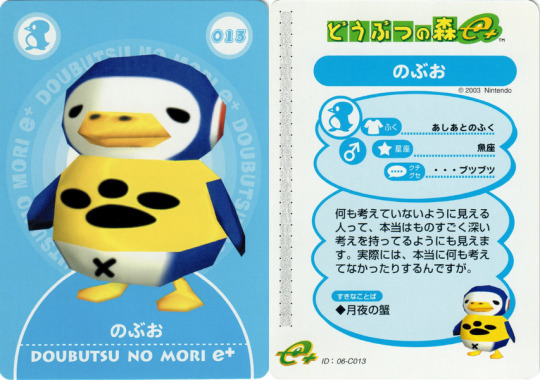
ZOE
Amiibo Card art:

Other Names: Cléo, Naricia
Original Name: Bifun, Zoe
Birthday: 10th February
A Normal anteather that appeared In the original Animal Forest, Animal Forest+, Animal Crossing, and Animal Forest e+
E-card description: Zoe doesn't just use her impressive nose to catch insects. That girl writes with her nose too! Unusual? Yes. Practical? You bet. Now she can write and plant flowers at the same time.
Original art:


ACE
Amiibo Card art:
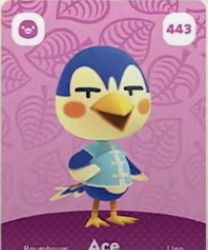
Other Names: Boumboum, Uno, Asso, Helge
Original Name: Feza, Ace
Birthday: 11th August (originally a Pisces)
A Jock Bird that appeared in Animal forest, Animal Forest+, Animal Crossing, Animal Forest e+
E-card description: Ace knows every fish-filled pond and puddle. But this avid fisherman never sells his catch or donates it to the museum. His tender heart compels him to release each wide-eyed prize back into the water.
Original art:


RIO
Amiibo Card art:
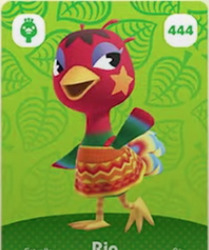
Other Names: Estrella, Rìo, Verona; Rita
Original Name: Dejaneiro, Rio
Birthday: 10th of September
Rio is a Peppy Ostrich who appeared in Animal forest, Animal Forest+, Animal Crossing, Animal Forest e+
E-card description: Rio has such a fixation on health food that is almost UN-healthy. Eating fruit is well and good, but Rio's always falling for the latest health food craze... Even if it involves eating tree bark.
Original art:
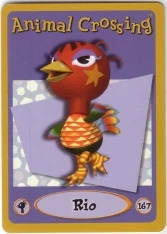
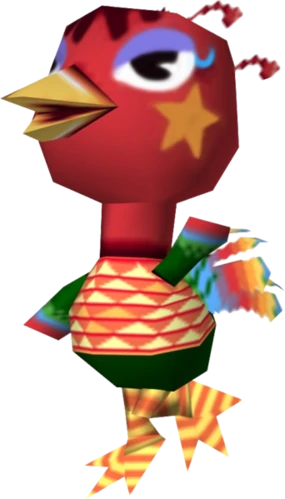
FRETT
Amiibo Card art:

Other Names: Foufou, Ulises, Juppi, Lionello
Original Name: Champagne
Birthday: 30th October (originally a capricorn)
Frett is a cranky dog that first appeared in Animal Forest e+. He could be obtained only by scanning his e-reader card
E-reader Card art:

AZALEA
Amiibo Card art:

Other Names: Azalée, Jasmin, Ortensia
Original Name: Petunia
Birthday: 18th December
Azalea is a snooty Rhino that first appeared in Animal Forest e+. She could be obtained only by scanning his e-reader card
E-reader Card art:
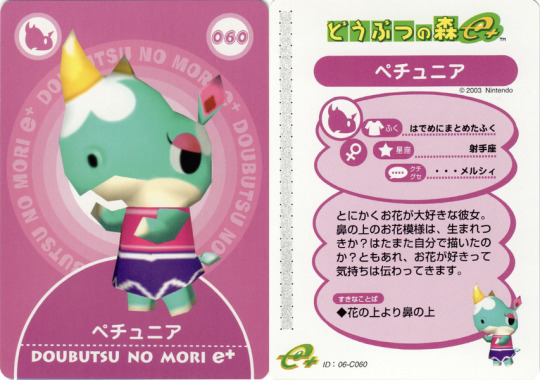
ROSWELL
Amiibo Card art:
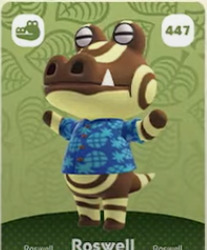
Other Names: Juri, Ulfo
Original Name: Pironkon
Birthday: 2nd May (originally a sagittarius)
Roswell is a Lazy alligator islander. He appeared on Animal Forest e+ and could be invited to the animal island by scanning his e-card
E-reader Card art:
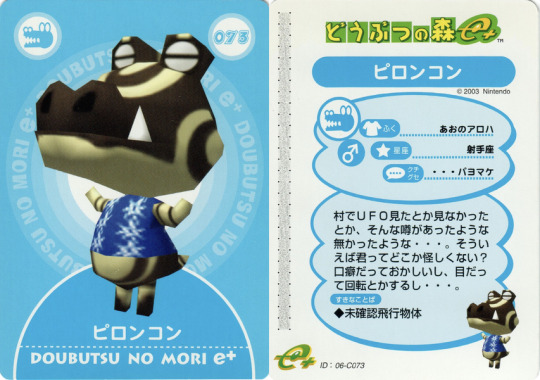
FAITH
Amiibo Card art:
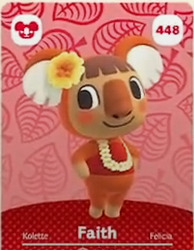
Other Names: Kolette, Felicia, Finchen, Calipso
Original Name: Machi, Faith
Birthday: 21th March
A normal koala islander from Animal Forest+, Animal Crossing and Animal Forest e+
E-card description: On Faith's island paradise, dreams take center stage. Faith is the star, and you are all just members of the supporting cast. Trees, flowers, waves, and everything else are all just part of the set.
Original art:
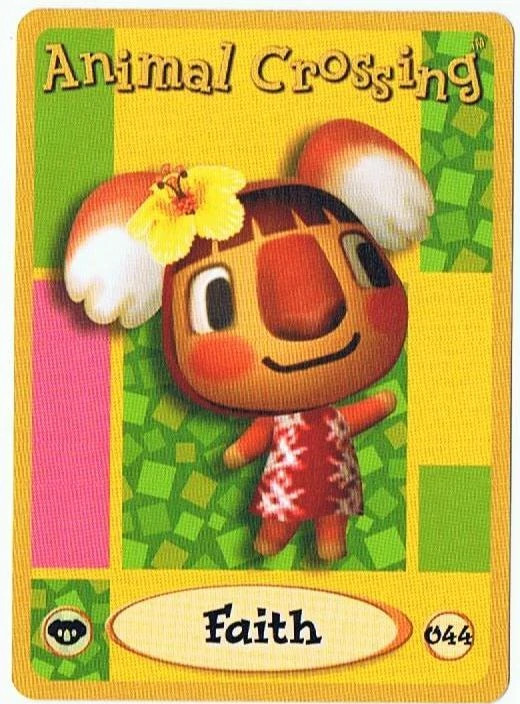
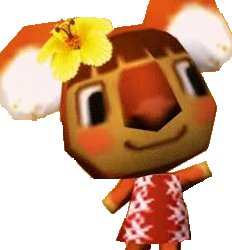
And that’s it! These are the 8 villagers that will come back in the 2.0 update! Note that their personalities may be changed in New Horizon! Hope you found this interesting!
If someone can provide an accurate translation of the japanese e-cards please do tell me! I’d love to have as much info as possible!
17 notes
·
View notes
Note
What was the honest reaction to Sonic 06 back in 2006?
It was a long time ago, so I can only really speak to my own perspective.
Sonic 2006 was the time that Sega’s marketing department really started cranking the hype train really, really hard. Sonic 2006 was announced as a fresh start. A soft reboot. Sonic Team said they were treating it like “the first Sonic game on the Sega Genesis.” You still had Tails, and Knuckles, and Shadow, but it was the start of a new era. A new type of Sonic the Hedgehog. More serious, more realistic, more “epic.”
At this point, there was no reason to necessarily distrust any of that. Yes, Sonic games had been slipping in quality, and yes, Sega was still more or less pretending that everything was “okay.” But that was always in the typical, “we’re trying to sell a video game and not go bankrupt” sense. This felt like a tacit acknowledgement that things weren’t so great and they were going to start over and refocus. Set things right.

Early gameplay footage looked rough. I distinctly remember a Gametrailers hands-on where they were demoing the Mach Speed Zone in Kingdom Valley, and the Sega representative was very clear and upfront that the game wasn’t done yet, and all of the empty space Sonic was running through would be filled in later. (It wasn’t.) There was also the typical debate over the TGS 2006 “Bringing it Home” playable demo, where people argued then, too, that the game wasn’t done yet, and not to judge things too harshly. The final version will be better.
The final version also wasn’t done yet. So, y’know.
I had effectively bought an Xbox 360 for this game. I was broke as per usual, but I’d gotten lucky and won a Gametrailers video competition, which landed me $1000 in Gamestop gift cards. I bought a PS2, a Nintendo DS, and an Xbox 360, plus more than a dozen games between the three platforms. I knew there would be more Xbox 360 games besides Sonic 2006, and I’d even originally wanted a 360 primarily for Elder Scrolls Oblivion, but the simple fact is that once the money was in my hands and I spent it, Sonic 2006 was the only actual Xbox 360 game I owned.
Or was going to own, anyway. I think I’d won the contest in September or October of 2006, when Sonic came out in November. So I bought the 360 a few weeks early with some original Xbox games, and spent the interim with Spider-man 2, Ninja Gaiden Black, and the copy of Halo 2 I borrowed from my cousin.
Sonic 2006 was the first game I’d ever pre-ordered. The second game, pre-ordered on the same day, was The Legend of Zelda: Twilight Princess for the Gamecube. I still have the tiny pre-order statue that came with Sonic. His gloves and socks, once white, have begun to yellow with age, and the skin tone on his face and body is turning an ashy gray.

Even 72 hours before launch, there was not a clear picture what Sonic 2006 actually was. Sega was deliberately obfuscating certain features; early in development they’d sworn up and down that there were only three playable characters in the game, something that blatantly wasn’t true. Perhaps it was miscommunication from Japan, but it meant they were now going out of their way to hide how many other playable characters were actually in the game. I naively distrusted most (if not all) professional reviewers back then, and the earliest scores for Sonic 2006 were all over the map.
As a Sonic fan, you kind of had to know how to read between the lines on the more negative reviews, because we were definitely in the era where it felt like critics were starting to dogpile on the Sonic franchise now that Sega was a third party developer. There weren’t a lot of professional reviews you could trust regarding Sonic games, or at least, that’s what it felt like. This was the rise of the podcast, and snarky hosts were taking whatever low hanging fruit they could get.
I remember waking up on launch day -- friends had gotten up early and picked theirs up in the morning, when I’d rolled out of bed somewhere closer to noon (or maybe even afternoon). I had plans to pick up my copy later that evening, after sunset. My friends did not sound happy, but again, there was always this vibe of “Wait and see.” They had only just started the game. First impressions were still too fresh to really call.
But I had this moment, this cold spot in the pit of my stomach, where I thought “Maybe I can cancel the pre-order and get Gears of War instead?” Reviews for Gears seemed pretty good. I’d probably be happy with it instead of Sonic.
I couldn’t let myself do that. I was a Sonic fan. This was the first big Sonic game of a new generation. A new start. I bought the console for this. First game I ever pre-ordered. The second Sonic game in the history of the franchise I’d bought on launch day. This was it. This was the event. No backing down. Besides, Sonic 2006 was a big 15th Anniversary celebration game. They wouldn’t make such a big deal about the anniversary without just cause, right? Sonic 2006 was going to be great. I just needed to calm down.

So we drove out to Gamestop -- and it was the sort of thing where I think we couldn’t do the pre-order at my local Gamestop for some reason, so this one was a town or two over. It was a journey. I was nervous the whole way there. Something told me I was making a mistake. But I had to do this.
I think it may have been starting to rain as we rolled up on the store. It was around 8pm, and people were starting to camp out on the sidewalk. Literally camp out, tents and all, because of the rain. Today was the launch date for Sonic 2006, but tomorrow was the launch of the Playstation 3. These guys were here for Gamestop’s “Midnight Madness” launch event. They were going to be some of the first to get a PS3. I was probably the last person to pick up a Sonic 2006 pre-order.
Sonic 2006 might have been the first Sonic game to ever make me angry. I’d had a lot of internet debates on how I felt about Sonic Adventure 2, but most of those amounted to splitting hairs about things that felt disappointing when compared to the original Sonic Adventure. I was not angry then, I was simply let down. I was similarly let down when I finally got a chance to play Sonic Heroes. But again, not angry. Baffled, maybe. A little sad. But not angry.
With Sonic 2006, I slammed head first in to all of my excitement and uncertainty at 200mph. This was a Sonic game unlike anything I’d ever played before, and in all of the worst possible ways. Enough has been said about the quality of the game that I don’t need to describe anything that’s wrong with it -- also because literally everything was wrong with it. Perhaps the first video game I’d ever played, ever, on any platform, that actually fought back against your efforts to play it. A disaster in every sense of the word. A broken nightmare. After finishing Sonic’s story, I was mad. How could they let this happen? What was wrong with them?

I was less angry after having finished Shadow’s story. Shadow had even buggier gameplay than Sonic, but it also felt more complex, more action-oriented. His story was better, too -- instead of the sappy Princess love story, Shadow’s story was about how the world was against him, and the crossroads that brought him to: rise above his past and strive to be a better person, or give in to the temptations of evil? It was still dumb as heck, but it was less dumb than Sonic’s story.
By the time the credits rolled, I had accepted the fact that this game was a mess. More of a mess than any Sonic game ever had been before. It was clearly a deeply unfinished game. Friends theorized maybe they could patch the game, because that was a thing games could get now. Sonic 2006 could still be saved. The PS3 version wouldn’t be out for another month, surely that means they’re working on a fix, right? Some were even theorizing over an achievement called “Nights of Kronos” -- it mentioned a “complete ending to the last hidden story.” Perhaps that meant there was going to be more? Maybe we got the bad ending, and a better, more finished ending was waiting for us on the disc somewhere?
There wasn’t. And no patch ever fixed the game. That was Sonic 2006 -- the kiss, the loading screens, the strange mannequin NPCs, the stiff controls, the glitchy physics, the empty overworlds, the bizarre dialog, the plotholes and time paradoxes, that’s just what the game was, and was always going to be, forever.
Before Sonic 2006, you could say that 3D Sonic games were bad, but there was always a place to defend them from. They had problems, but they were never irredeemable. Sonic Heroes may have had frustrating controls and repetitive level design, but it had great art direction, nice music, and fun concepts. They were always trying, dang it, and it was obvious to see that.
Sonic 2006 felt irredeemable. Offensively terrible. A failure on such a level that it was hard to comprehend. Beyond simply “a new low” for the franchise. This felt like rock bottom. It was the kind of bad that spread like a virus. Even good games, like Sonic 2 on the Sega Genesis, felt notably tarnished by the existence of Sonic 2006. It threatened to ruin the entire franchise by proximity alone. For some, it probably did. I definitely had a moment where I wondered if I would ever enjoy a Sonic game in the same way ever again. They were all tainted now. Infected by memories of Sonic 2006, the game that was supposed to save the franchise, but condemned it to the lowest pits of hell.
In isolation, that might have been the end for me. I might have continued to drift away, bit by bit, until I found greener hills outside of the Sonic franchise.
I’ve said this before, but what saved me was getting hired to write for TSSZ News. Now, suddenly, I was paid to play and write about Sonic games. It was a duty. And it helped that the first Sonic game I reviewed for TSSZ ended up being Sonic Unleashed, a game I continue to openly gush about to this day, more than a decade after its release.
But never forget that Sonic 2006 was such a disaster that it nearly made me give up Sonic the Hedgehog. It really was that bad.
33 notes
·
View notes
Text
Friday Special #9
January 30th, 2021
So I was digging through my bag of DS and GBA titles, and noted that one of them was a Game Boy Advance VIDEO cartridge that contained the first two episodes of Sonic X. Popped it into my DS to relive some nostalgia and it occurred to me that there isn’t anything like this anymore besides those PSP UMD VIDEO disks that had whole movies on them.
So where did they come from and how did they come to be?
For this week’s Friday Special, we’re gonna find out.

For a little backstory, the Game Boy Advance handheld console was released back in 2001 and it was marketed as the successor of the Game Boy Color. With its resolution of 240 x 160 pixels (which was a lot at the time), 15-bit RGB Color Support (it was capable of producing 512 colors in character mode and 32,768 simultaneous colors in bitmap mode), and Dual 8-bit DAC for stereo sound, it was a fascinating machine and a work of technical art. It was super successful world-wide and garnered millions in sales.
So what exactly were the Game Boy Advance Video titles?
The Game Boy Advance Video cartridges were a special class of cartridges where based on the amount of memory, it featured one to four episodes of popular shows of the time like those from Cartoon Network and Nicktoons.
Here is the complete list of games:
GBA Video Movie Pak vol. 1
Shrek
GBA Video Movie Pak vol. 2
Shrek 2
GBA Video Movie Pak vol. 3
Shark Tale
GBA Video Movie Pak 2-Movies-In-1!
Shrek
Shark Tale
GBA Video Movie Pak 2-Movies-In-1! Vol. 2
Shrek
Shrek 2
The Adventures of Jimmy Neutron vol. 1
"Brobot"
"The Big Pinch"
"Granny Baby"
"Time is Money"
All Grown Up! vol. 1
"Susie Sings the Blues"
"Coup de Ville"
Cartoon Network Collection vol. 1
Ed, Edd 'n Eddy: "Stop, Look and Ed"
Courage the Cowardly Dog: "Magic Tree of Nowhere"
Johnny Bravo: "The Perfect Gift"
The Grim Adventures of Billy & Mandy: "Crawling Niceness"
Cartoon Network Collection vol. 2
Codename: Kids Next Door: "Operation T.U.R.N.I.P."
Courage the Cowardly Dog: "Courage the Fly"
Johnny Bravo: "Balloon Platoon"
The Grim Adventures of Billy & Mandy: "Mandy the Merciless"
Cartoon Network Collection Limited Edition
Ed, Edd 'n Eddy: "Key to My Ed"
Courage the Cowardly Dog: "The Queen of the Black Puddle"
Codename: Kids Next Door: "Operation M.I.N.I.G.O.L.F."
Dexter's Laboratory: "Big Sister"
Cartoon Network Collection Platinum Edition
Codename: Kids Next Door: "Operation T.O.M.M.Y."
The Grim Adventures of Billy & Mandy: "A Grim Surprise"
Courage the Cowardly Dog: "Cowboy Courage"
Ed, Edd 'n Eddy: "The Luck of the Ed"
Cartoon Network Collection Premium Edition
Dexter's Laboratory: "Double Trouble"
Courage the Cowardly Dog: "The Shadow of Courage"
Johnny Bravo: "Cookie Crisis"
Ed, Edd 'n Eddy: "A Glass of Warm Ed"
Cartoon Network Collection Special Edition
Ed, Edd 'n Eddy: "Oath to an Ed"
Johnny Bravo: "Beach Blanket Bravo"
The Grim Adventures of Billy & Mandy: "Billy and the Bully"
Dexter's Laboratory: "Dexter's Rival"
Codename: Kids Next Door vol. 1
"Operation R.E.P.O.R.T."
"Operation N.O.-P.O.W.U.H."
"Operation B.R.I.E.F."
"Operation D.O.G.F.I.G.H.T."
Disney Channel Collection vol. 1
Lilo & Stitch: "Slushy"
Kim Possible: "Ron the Man"
Disney Channel Collection vol. 2
Lilo & Stitch: "Poxy"
Kim Possible: "Rufus in Show"
Brandy & Mr. Whiskers: "To The Moon Mr. Whiskers"
Dora the Explorer vol. 1
"3 Little Piggies"
"The Big River"
Dragon Ball GT vol. 1
"A Grand Problem"
"Pan's Gambit"
The Fairly OddParents vol. 1
"Foul Balled"
"The Boy Who Would Be Queen"
"The Information Stupor Highway"
The Fairly OddParents vol. 2
"Father Time"
"Apartnership"
"Ruled Out"
"That's Life"
Nicktoons Collection vol. 1
SpongeBob SquarePants: "Pizza Delivery"
The Fairly OddParents: "The Big Problem"
All Grown Up!: "Chuckie's In Love"
Nicktoons Collection vol. 2
SpongeBob SquarePants: "Nature Pants"
SpongeBob SquarePants: "Opposite Day"
Rocket Power: "The Big Air Dare"
The Fairly OddParents: "Odd Ball"
Nicktoons Collection vol. 3
SpongeBob SquarePants: "Squeaky Boots"
The Fairly OddParents: "Tim Visible"
Danny Phantom: "Attack of the Killer Garage Sale"
Pokémon vol. 1
"For Ho Oh The Bells Toll"
"A Hot Water Battle"
Pokémon vol. 2
"Playing with Fire"
"Johto Photo Finish"
Pokémon vol. 3
"Pokémon, I Choose You!"
"Here Comes the Squirtle Squad"
Pokémon vol. 4
"Beach Blank-Out Blastoise"
"Go West Young Meowth"
The Proud Family vol. 1
"Twins to Teens"
"Tween Town"
Sonic X vol. 1
"Chaos Control Freaks"
"Sonic to the Rescue"
SpongeBob SquarePants vol. 1
"Bubblestand"
"Ripped Pants"
"Jellyfishing"
"Plankton"
SpongeBob SquarePants vol. 2
"Mermaidman & Barnacleboy"
"Pickles"
"Hall Monitor"
"Jellyfish Jam"
SpongeBob SquarePants vol. 3
"Walking Small"
"Texas"
"Hooky"
"Mermaidman & Barnacleboy II"
Strawberry Shortcake vol. 1
"Meet Strawberry Shortcake"
"Spring for Strawberry Shortcake"
Super Robot Monkey Team Hyperforce Go! vol. 1
"Depths of Fear"
"Planetoid Q"
Teenage Mutant Ninja Turtles vol. 1
"Things Change"
"A Better Mousetrap"
Yu-Gi-Oh! vol. 1
"Friends Until the End Part 3"
"Friends Until the End Part 4"
Although the first of the GamePaks (the other name that they went by) started to appear in 2004, the original name was GBA-TV a year earlier. The first cartridges to be released in May of 2004 were when Majesco was able to acquire rights for 4Kids properties such as Sonic X and Yu-Gi-Oh! for the earliest released titles. Later in June, select shows from Nickelodeon, Cartoon Network, Nick Jr., and Funimation were added to the line-up when Majesco acquired the rights. The Disney Channel soon was added as well late in November of that year, creating even more cartridges for the roster. That next November in 2005 was the time for when Majesco was able to acquire the rights for Shrek, Shrek 2, and Shark Tale from Dreamworks, where for the first time, the Game Boy Advance Video series would now feature full-length movies, which was a marvel at the time due to the Game Boy Advance’s limited memory.

In total, 36 cartridges were made in the entire line-up with more slated for released but were cancelled for various reasons, whether they be because of low sales of previous cartridges or copyright issues.
Here is the complete list of cancelled games:
Drake & Josh vol. 1
"Pilot"
"Dune Buggy"
Even Stevens vol. 1
"Swap.com"
"Stevens Genes"
Kirby: Right Back at Ya!
Ugly Betty vol. 1
"Pilot
"The Box and the Bunny
Sonic X vol. 2
"Missile Wrist Rampage"
"Chaos Emerald Chaos"
Teenage Mutant Ninja Turtles vol. 2
Yu-Gi-Oh! vol. 2
Speaking of copyright, there is a reason that the GamePaks were only viewable on Game Boy Advance systems as well as the first two DS systems but not the GameCube's Game Boy Player accessory. It was because the owners asked Majesco to make it so that making the games incompatible with the GameCube’s GBA Player would protect their properties from getting ripped onto VHS tapes and DVDs, which was what the Player was capable of doing. It would not have mattered however, because the low quality would have shown on the TV, making the ripping process useless.
The low quality of the cartridges were due to the heavy compression of files in order for them to fit on a GBA cartridge, causing noticeable artifacts on the screen, even more visibly on a later system like a DS console. The low quality was the biggest disadvantage for the Game Boy Video cartridges as they eventually became obsolete by the late 2000s/ early 2010s when the DSi was released with no backward capabilities.
Despite them being obsolete by today’s standards, they can still be found online on shopping sites like eBay and depending on the condition can go for a pretty penny. The rarest one in the entire roster is the cartridge for Super Robot Monkey Team Hyperforce Go! vol. 1 as only a limited number of copies were made and are now so rare that they can fetch almost $200 on eBay, where that is the only shopping site to even have them for listings.
It should be mentioned that around the same time, Sony was releasing PSP UMD (Universal Media Disc) Video disks for their PSP systems that were capable of playing whole movies, but that’s an article for another time.
Thoughts From the Head
As stated above, I actually do have one of the Game Boy Advance Video cartridges in the form of Sonic X Vol. 1 that I had bought years ago at a local video game store. It still works, and although you can definitely see the age on a DS screen, it’s still super impressive how much they had to compress in order for the data to fit.
It’s still a really neat piece of history and it’s something that would’ve never happened in today’s age of gaming with everyone being as tight-lipped about copyright to the point of it being detrimental to creativity. That being said, if you have a GBA, its succeeding systems or the first two DS systems, I’d say to track them down while you can, especially if your favorite show is on the list (unfortunately, I have no hope of getting the Super Robot Monkey Team Hyperforce Go! vol. 1 cartridge as that is like trying to find an ant in a haystack but I have the Sonic X one and that’s good enough for me).
Here’s some photos of mine!

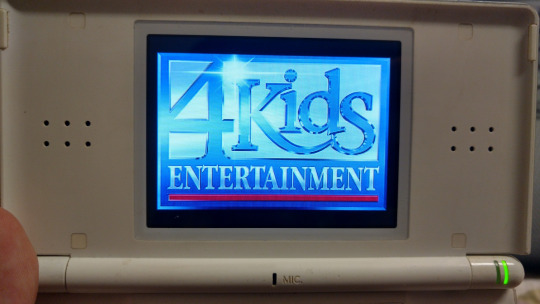


So do y’all think about all of this? Share your thoughts in the comments!
Thank you for reading!
13 notes
·
View notes
Text
Been playing the Final Fantasy: Crystal Chronicles remaster some since it dropped, and I have some thoughts on it. It’s been a…really long time since I last played the original, and I never was able to get too far in, since I was so new to video games that I was unable to intuit most of its mechanics. Despite this, I fell in love with the game. For quite some time, it was the only game with “Final Fantasy” in the title that I had played. I played, enjoyed, and beat its three sequels: Echoes of Time, Ring of Fates, and The Crystal Bearers (neither of the My Life As spinoffs, but eh).
This remaster is not a good remaster, but mostly not for the reasons I’ve seen put forth online. The developers didn’t do much to improve the visuals, sure, but honestly the art direction of the game was pretty enough anyway that it skates by on that alone. The load screens are not nearly as long as I’d been led to believe. The gameplay is unchanged from the original, and like…I like the gameplay of the original? That’s why I played the remaster? I want to play the game?
My biggest issue with the remaster is how the online is handled, but reviewers have straight up lied about problems with the online? Like…you have a permanent friend code you can give people. The temporary online codes you can generate are different from the permanent one. Why are reviewers saying your online code changes every 30 minutes and you can’t save permanent friends when that’s demonstrably false? Seems like a thing you maybe shouldn’t be writing in your official review.
I’m going to put my own issues with the online aside for a moment, though. I promise we’ll come back to it, but my issues with the remaster are only understood in the larger context of what the game did as a piece of art and what it no longer does now as a result of the changes. First, then, we’ve got to lay down what Crystal Chronicles did as a piece of art. Crystal Chronicles, I’ve come to realize during this playthrough, is a game about storytelling as collective memory, and much of the game’s mechanics work in service to this theme.
In the world of the game, something happened long ago that released poisonous miasma into the air and made much of the world uninhabitable to the four major races. The game follows the players’ customized characters as they take annual pilgrimages to collect enough “myrrh” from magical trees, which is used to maintain the barrier that keeps their town safe from the miasma. The game is broken up into years; it takes four drops of myrrh to maintain the barrier for a year, each dungeon’s tree only provides one drop of myrrh, and it takes several years for a tree to replenish that drop, pushing the characters’ caravan further and further out each year in search of trees that are not yet spent.
I’ve compared this setting to Death Stranding a few times in the past, and I think the comparison holds up. The game’s story has only gained something from the current moment, too. I go out and risk myself to get groceries, which I then bring back home so I can continue to hole up safe in quarantine until I run low again, and I think the game fairly accurately simulates the rise and fall of that pattern, the balance of risk and safety, and the way the dangerous unknown eventually becomes the mundane with time. Most of the locations in the game are old products of civilization that have been lost to nature, and walking through former farmland, abandoned roads, and empty towns in the game do remind me of walking down empty city streets back when coronavirus was still keeping people off city streets.
The game has several stories running in tandem, but the most central one is the ongoing story of the characters’ caravan, chronicled in a journal. After every new encounter, new area, or completed dungeon, a new entry is added to the journal, and at the end of the year, all the entries are incorporated into a cutscene, so the player can read them and relive the year’s events. The entries are very short and written in a simple style, but they still give the player an idea of how their character viewed the events. These end-of-year cutscenes are actually really enjoyable little rituals, and I’ve been avoiding reading the journal entries specifically so I can experience them for the first time in these retrospectives.
As the years progress, the character’s entries show that their memories of earlier years are fading. “Whenever I close my eyes, I vividly remember all my adventures,” says the entry at the end of the first year. By the end of the fourth year, however, “so many memories from my earlier adventures have dimmed, from the joys of chance encounters to the suspense of my first battles.” The entries also show the ways the annual pilgrimages have changed the player character. “It was an easy fight, so I spent a peaceful interlude over a light meal,” says an entry after revisiting an older dungeon. “I was a little surprised. I never considered myself a fighter.”
The written and oral records of the past permeate this game in so many ways. Before each dungeon, a narrator who is presumably another caravanner who went to the same places in the past introduces the location with either a history of the place or an anecdote about the place. The Mushroom Forest, to her, evokes a childhood memory of her mother. She introduces the Veo Lu Sluice by explaining the history of who built the sluice, what conditions allowed for its construction, and what its irrigation has done for the people since. After each dungeon, the player character receives a letter from a family member, telling them what has been happening in the town while they were away. At the beginning of each new year, the town’s patriarch tells your character a story about the previous caravanner, who mysteriously disappeared after announcing he had found a way to remove the miasma entirely.
It feels like history, generally, has been put on hold. The Lilty military once dominated most of the world, but had to shrink back into their capital city due to the miasma, and the city eventually diminished to a small trading post. The Yukes once were at war with the Lilties, but they’ve allowed trade between their towns again, so caravans can have safe havens to stay in while collecting the precious myrrh. The once-nomadic Selkies were unable to find a new homeland before the miasma spread, and now most are stuck on an island that was supposed to be a temporary stop. We hear much of this history throughout the game, but we don’t see any of it. It’s recorded and known but has little bearing on the culture or lived experiences of the inhabitants of a world where no one can leave their homes.
The moogle adventurer Stiltzkin asks the player character where memories go once they’ve been forgotten, and it’s a fair question in a world where everyone is as alienated from the past as they are from each other
The problem is, this isn’t supposed to be a game about alienation, exactly. It’s supposed to be a game about shared experiences and the ways we experience and remember the same events differently, as different individuals. It’s supposed to be a game about combatting alienation through shared experience. This is supposed to be a game in which I share a screen with three other players even as we each also have our own personal screens providing us with different objectives and showing us different letters from our different families.
In the original game, the multiplayer was devilishly difficult to actually set up, as each player had to have their own Gameboy Advance, attached to the Gamecube and used as a controller, to control their own character. The players’ characters lived in the same town and were on the same caravan together but competed over who unlocked which powerups and picked up which recipes, meaning everyone’s stat spread and armor was different. Players had slightly different experiences within the larger shared story, and the use of the Gameboy Advances were meant to highlight those differences.
Which leads to my issue with this remaster. In the original, characters were saved to the same file, and every player’s character lived together in the same town. Their families each had different houses in the towns and would eventually provide the party with different supplies, depending on their jobs and the responses they received to their letters. At the end of each dungeon, the player characters would sit together in a circle and each receive a letter from their families. At the end of each year, the retrospective cutscene showed the characters and their families celebrating their return together. Your characters explored towns together, and your fellow players watched the random encounter cutscenes with you.
In this game, you can’t play local multiplayer at all. You can only play online multiplayer in dungeons, and clearing a dungeon with other players only counts towards the host’s file. At the end of each dungeon, the characters sit in a circle as the mail moogle tells all but the host that there is no mail for them. At the end of each year, the retrospective cutscene shows an almost entirely empty town; the character and his immediate family dance alone. Certain secrets have now been relegated to the single-player experience only, and the minigames you could unlock and play with friends were removed entirely. Towns are also exclusively single-player. The game is no longer a shared multiplayer experience so much as a dungeon-crawler where friends and strangers can jump into dungeons to offer brief help.
This creates a strange two-minded state of play, where I see and remember the vestiges of the game that once was while playing a game that’s in thematic opposition to it. As my character explores Tida Village and sees signs of the population that once lived there, I play this remaster and see leftovers from now-removed game mechanics. It’s a deeply unsettling and alienating experience.
The online isn’t inherently bad, then. It reminds me of FFXIV, where dungeons and bosses are their own separate experiences, removed from the rest of the game. But this online is inherently unsuited to the game it is in. Crystal Chronicles is not FFXIV; the developers put together a system of online play for a different game than the one they were remastering.
It would have been possible to change the game to suit this online system, too! The journal entries for dungeons could have also included the names of players who joined them for those dungeons. The online players could have still received letters, but from the host character’s family, thanking them for keeping their loved one safe. New random encounters could have been added between different online caravans, allowing them to trade items or play minigames with one another. The party at the end of the year could have included the families of randomly selected online companions These changes could have could have given us a synthesis of the old and new, and helped to center the chronicles over the crystals.
Instead, though, we have this incredibly flawed remaster, after almost a year of delays, that serves more as an empty reminder of what the game once was instead of actually allowing us to experience that game, or instead of, god forbid, actually building on that game’s premises and promises. I’m still enjoying the game a lot, but the experience is hella soured by my knowledge of how the game used to play. I’m not sure how enjoyable this remaster would even be to someone unfamiliar with the original.
This remaster feels like a purposeful nail in the coffin of Crystal Chronicles; an excuse to show that the franchise is no longer a potential seller. Whether that’s its actual intent doesn’t really matter, though, since I fear that will be its ultimate effect either way.
11 notes
·
View notes
Note
Honestly, I wonder if IS hired new ppl into the company, and instead of testing their abilities by putting them to work on a small project (like gamefreak does), they put them to work on 3h. That would explain all the "incompetent" answers in the Nindori interview, how they forgot to put actuall important lore into the game (The Claude true name thing), the low quality-pixelated textures, 3d models and animations... It isn't going to help future entries if they keep doing this, seein 3h sales.
Honestly I wouldn’t say that any of those things you mentioned are really what’s worth criticizing here. I haven’t read the full transcript of any of the interviews and my memory of them isn’t the best, but I tend to think of those kinds of things as more expressions of content creators’ visions than of the quality of the actual products. And FE16 is indeed a very arthouse-y, take-what-you-will out of it kind of game, with a heavy foundation in Jugdral so that part at least flies with me. As for the rest:
Claude’s real name is irrelevant to the plot(s) and tells us nothing about his character that we didn’t already know. At best it’s trivia. For comparison, it’s stated explicitly in in-game text that Yuri isn’t going by his real name either, and in his S support he shares that name with Byleth although the player doesn’t hear it. I cannot imagine a scenario in which it would add anything of substance if we were told at some point what that real name was, except again as a point of trivia. There are major issues with the lore and lore presentation of this game though, notably in the over-reliance on lategame exposition dumps and all the vague and sometimes contradictory backstories. Rhea, Edelgard, and Dimitri all get hit with that last one to varying degrees, and with Edelgard especially the dodgy writing has required people to reinterpret her as an emotionally manipulative liar in order to make sense of everything.
I said this before the game came out, but realistic graphical quality has never been a selling point of console FEs and - looking more broadly - of Nintendo’s library in general. You can’t look at Path of Radiance and say that its 3D elements don’t look awful for a non-launch Gamecube title, and it will never cease to surprise me that Genealogy came out the same year on the same hardware as Super Mario RPG or the third Donkey Kong Country game. Personally I was going to be satisfied with Three Houses’s graphics provided they were better than those of the last console release, and this game does in fact look better than Radiant Dawn (in terms of assets used, at least; it’s more a matter of opinion whether the switch from static portraits to models for cutscenes and supports is more dynamic or just clunky and awkward). If anything bugs me about the visuals here it’s the various uncanny valley CG art, not anything as technologically-involved as the models or textures.
I’m not one to ask about development cycles, or who was working on what projects, but I’m not overly concerned about FE16′s financial performance especially relative to the 3DS titles. It seems to be a general rule that console games don’t sell as well as handheld ones, a point that often gets brought up when addressing the terrible sales of the Tellius games compared to their GBA predecessors, and in any case I doubt IS cares very much when Heroes is their big money-maker for FE now and will probably continue to be for the foreseeable future. Mobile gachas are just more profitable for a much smaller investment of money and effort, and while I don’t play Heroes myself I don’t see anything wrong with the company leaning on the proceeds while they stick members of their team on “artsy” original pieces like Three Houses or remakes of older games. Remakes don’t seem to sell very well either, but they’re effective for feeding the nostalgia loop of Heroes.
Basically, Three Houses has its fair share of problems, but I don’t think you can attribute them to developer inexperience or incompetence. Well...most of the time anyway; some of the writing choices here are extremely questionable.
13 notes
·
View notes
Text
The Master of Blasting

Months ago, once I realized my Retron had a save-state feature, something got into me. I realized I could go back to old retro games and actually finish them. Sure, I played 100s of games in the 8 & 16-bit eras, but I’ve never been that good at anything with a steep difficulty. Most games of the late-80s, early 90s were punishingly tough and typically, without cheat codes I never got to see the end of them.
After playing through all the old Donkey Kong Country games and Sonic the Hedgehog 1, I turned my eye towards a peculiar series I had only dabbled in before, Blaster Master. With the release of Blaster Master Zero on Switch, I was extra interested in diving into the well-regarded B-tier NES original.
With a little research, I found that a total of 8 Blaster Master games have been released...that’s when the classic Sergio completist kicked in. I convinced myself that I shouldn’t play the new Switch games until I’ve completed all of the retro titles. When I began my journey I didn’t realize it would be such a headache. Here’s my run-through of all the Blaster Master Games.
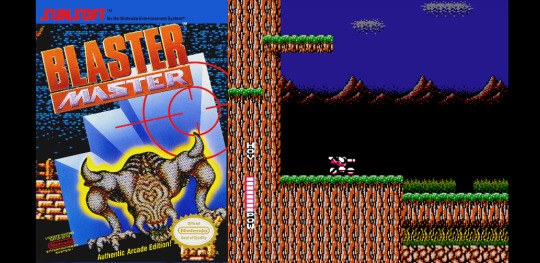
1988 - Blaster Master (NES)
Ah, the original. This little game has a charm to it that most games of the late 80′s don’t have. It was clearly inspired by Nintendo published games like Metroid and Zelda. Blaster Master’s key gimmick is the ability to play as the armored tank Sophia the 3rd or as an on-foot character named Jason, the pilot of the tank. As needed, Jason jumps out of the tank and enters human-sized doors.
Blaster Master is a 2D platformer, but once Jason enters a door, the game switches to an overhead perspective for navigation through maze-like dungeons. None of the mazes are particularly hard to solve, but all of the game’s bosses are found in these dungeons. As a kid, having a game that completely switched perspectives was rad. I never owned it as a child, but I vividly remember my time with it through rentals and such.
This first game is super hard and I found myself using known glitches to get past the game’s harder boss sequences. In true Metroidvania-style, there’s heavy backtracking throughout Blaster Master and if you don’t know where you’re going getting to the next level can be quite annoying. Having played the whole game, I can finally say that despite a super strong first impression, Blaster Master isn’t that great.
It's WAY too hard and by the halfway point the luster had worn off the unique gameplay. For some reason, this is the point where I decided to dive headfirst into the rest of the Blaster Master games. I’m a glutton for punishment I guess.

1991 - Blaster Master Boy (Game Boy)
Prior to playing the original, I had no idea there were so many titles in this series. I definitely didn’t know there were multiple portable entries. Blaster Master Boy is less a Blaster Master game and more a Bomberman game. Technically its a sequel to the Bomberman spin-off Robo-Warrior. A quick trip over to Youtube can confirm that the gameplay and music are lifted directly from Robo-Warrior. To add even more confusion, in Japan, Robo-Warrior was called Bomber-King, Blaster Master Boy was Bomber-King Scenario 2 and it wasn’t even published by the same company.
Because of this weirdness, I didn’t spend too much time with Blaster Master Boy. It also didn’t help that there isn’t a decently priced copy anywhere on the internet.
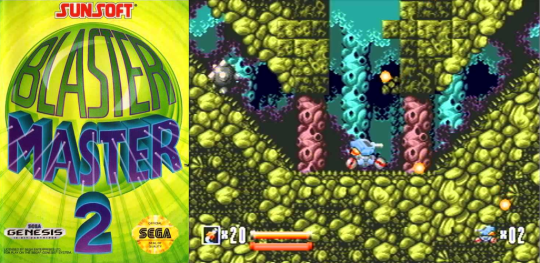
1993 - Blaster Master 2 (Genesis)
Five years after the original, Blaster Master returned to the console market with Blaster Master 2. It was a Sega Genesis exclusive and the only title in the series released in the 16-bit era. Playing this immediately after the original really made it quite hard. The controls aren’t as precise and the difficultly level is somehow ratcheted up. Blaster Master 2 is a more straight forward platformer without the backtracking of a traditional Metroidvania.
Unlike the first game, when you enter the human sections of the game, you don’t start a top-down sequence. Instead, the pilot levels are 2D platform shooter areas. All of these seem half-baked, clunky and compared to the game’s contemporaries, quite sad. Fortunately, top-down gameplay wasn’t completely abandoned, before the end of each level there’s an odd top-down sequence, where you pilot Sophia. This mechanic never returns in future games, but taking the rest of the game into consideration, it really isn’t terrible.
Unfortunately, there’s not much good to say about Blaster Master 2, It hits most of the design notes that the first one hits but the entire experience feels like it was made by a completely different team. Funny enough, after saying that, I looked it up and Blaster Master 2 was, in fact, made by a completely different team. Ha!
The game’s only saving grace is its vivid color pallet and solid sprite design. Like the first game, the music solid, but unless you’re taking a trip through the whole series like me, Blaster Master 2 can be skipped.
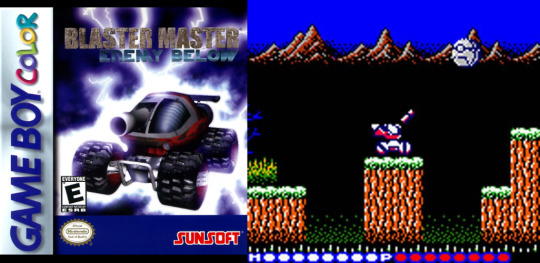
2000 - Blaster Master: Enemy Below (Game Boy Color)
It took Sunsoft awhile to get around to the Blaster Master series again, but in 2000 they came out swinging. Blaster Master: Enemy Below was released for Game Boy Color and of all the games on this list, it is the game that most resembles the original. Much of the art is designed to look nearly identical to the NES games’, even down to a nearly pixel-perfect recreation of the SOPHIA tank.
The top-down Jason segments return as does the extreme difficulty and fantastic soundtrack. It’s hard to really complain about the execution of this title. It was clearly an attempt at just trying to make the closest thing they could to the original and in many ways, it is a tighter and more consistent experience. Unfortunately, that’s also a strike against it. Enemy Below doesn’t bring anything new to the table. The bosses are basic re-hashes of the originals, the levels feel like a “lost levels” DLC pack and the game being portable doesn’t really encourage innovation.
I guess the coolest thing I can say about Enemy Below is that it's still available for purchase. On the 3DS Virtual Console, you can pick up Enemy Below for about $5. At that price, it’s easy to recommend, especially since it comes with built-in save-state functionality.
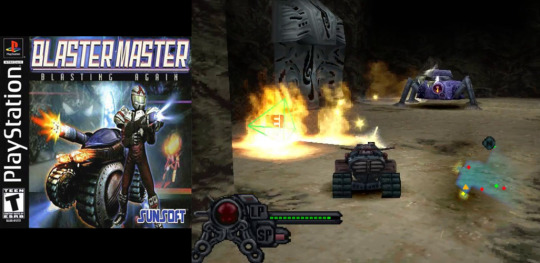
2001 - Blaster Master: Blasting Again (Playstation)
Also, released in 2000 (in Japan, 2001 in North America), is the weirdest game in the series to date, Blaster Master: Blasting Again. For those of you too young to remember, the Playstation/N64 era of video games was full of 2D series trying their hand at 3D games. Blasting Again is an egregious example of this frustrating industry trend. You still pilot a tank, with all the same features, like homing missiles, and hover, but you’re dropped into a fully realized 3D world with painfully bad anime cut-scenes.
The “Jason” sequences are still here, but they too are 3D and mundanely boring. Also, with this being an official sequel to the original, you play as Jason’s son Roddy, not Jason. Much of the music from earlier in the series is remixed, and rerecorded, so not all is lost in the odd one-off. Unfortunately, the antiquated tank controls and punishing difficulty makes Blasting Again hard to recommend. I was able to play it on PS3 with no issues, but the toggle switch for the digital and analog controls was initially hard to find.
I ended up sinking about 40 hours into finally beating this tragedy. I wasn’t able to use save states and despite it being objectively bad, I grew to love it’s janky and unfair presentation. As a whole, these games have really tested my ability to control my anger, but Blasting Again was the first one to truly get all the way under my skin.

2010 - Blaster Master: Overdrive (WiiWare)
Notice, I have yet to say any of these games are good, that’s because they aren’t. What they have is a charm to them that conjures the aura of the scrappy beginnings of gaming and the forced appreciation of only owning 4 games that had no checkpoints. Thus far, despite initial misgivings, I’ve enjoyed my time on this journey. Blaster Master: Overdrive is where that joy ended. The fun I was having with the series was taken out back, brutally beaten, and left to die in the town square as an example to anyone daring to play this absolute nightmare.
Overdrive starts innocently enough. It does it’s best to try and evoke the gameplay and tone of the original and for what it's worth the art style isn’t terrible. The Sophia and Jason gameplay loops are in-tact and even the gun-upgrades are more important than ever. Where Overdrive falls apart is its difficulty and embarrassing lack of control options.
I’m sure most of you are at least familiar with the Wii-Remote. With this being a Wii-Ware only game, it could only be played with the Wii-Remote. The real downside is that the developer either ran out of time or opted not to explore the myriad of control options the Wii offered. There’s no classic controller support, no Gamecube controller support, there’s not even a way to map buttons to a nun-chuck. You are stuck playing with the Wii-Remote turned sideways.
This wouldn’t be that big of a deal if they had found a better way to implement strafing into the controls. To strafe, the player must hold the B button. That’s the button underneath the Wii-Remote. In a world where the player is using the remote like an old-school NES controller, B button usage is a legit finger-bending-nightmare. Couple this broken control scheme with punishing difficulty and you have the perfect recipe for rage-quitting. I‘m not proud of my behavior during my time with this game and let’s just say I own 1 less Wii-Remote now.
The last thing I want to say about Overdrive is less about the game itself and more about its availability. The Wiiware marketplace is 100% closed, which means there’s no legit way to purchase this game, outside of buying someone’s Wii who had already bought it. This is an ominous foreshadowing of things to come. I would have paid for this game. Hell, I’m deep enough into this BM adventure I would have paid a premium to play this dumb game, but Nintendo’s shut-down of the Wii-Ware shop is a low-key attack on game preservation that us archivist, CANNOT forget. *steps off of soap-box*

2017 - Blaster Master Zero (Switch/Steam)
With the release of Blaster Master Zero, the series got the most attention it’s had since the original game. Most of that attention was because Zero was basically a launch game for the Switch. The best way to describe Zero is to say that it’s developer Inti’s attempt to take the Blaster Master formula and actually make a decent game. For the most part, they succeed. Oddly enough, almost 30 years later, Zero is the first legitimately good Blaster Master game.
Much like Enemy Below, Zero tries its hardest to evoke the look of the original NES game. Some refer to games like this as pixel art, others refer to it as lazy...I float somewhere in the middle on it. It was great playing a Blaster Master game with a proper controller where the mechanics actually work. However, it was frustrating seeing a game, based on a design aesthetic that hit its ceiling in the late 80s, try to beautify itself. Many attempts were made to make the design stand out, but it just kept hitting the ceiling established by its predecessors.
Alternately, by Inti making the game super-playable, the flaws of the older games stand out even more than before. Typically, good Metroidvania’s have an intuitive way of hinting at where you need to go next or a good way of telling you what access you’re new power-ups give you. Due to Zero’s obsession with evoking the original, that intuitive gameplay is replaced with a red box on the map screen. This turns the game into a “drive to red box, shoot things, drive to next red box and shoot more things, experience”, rather than the naturally explorative nature of other games in its genre. The anime story seemed unnecessary from the start, but I’m sure someone will enjoy it.
While playing Zero I honestly asked myself, “Is this game way easier than the older games, or can I finally control this little tank properly?” I’m sure the real answer is somewhere between those two extremes, but ultimately Zero was a blast, albeit WAY too easy. I’m really looking forward to seeing how the sequel improves upon this wonderful jumping-off point. However, I’m positive I’ll be disappointed that more wasn’t done to bring the series into the modern 2D-platforming space.

2019 - Blaster Master Zero 2 (Switch)
Zero 2 is very much a sequel to Zero. In true anime fashion, the story immediately gets super self-serious and consequently superfluous. I’m sure some players will love the dialog between protagonist Jason and all of the various anime-faced characters, but that’s not what I’m here for. Needless to say, the story gets involved in ways other Blaster Master games haven’t. That’s not a strike against it, it’s just a characteristic that may not actually matter.
All previous mechanics are intact here and new ones are introduced almost immediately. If Zero was truly the first good Blaster Master game, then the refinements introduced in Zero 2 make it...wait for it...THE BEST BLASTER MASTER GAME EVER MADE! It controls well, the levels are interestingly built, and where previous sequels in the series lacked innovation, Zero 2 is full of cool and weird, new stuff. The bosses are fresh and interesting, the Jason sequences have been enhanced with a brand new counter mechanic and the space travel segments add a level of depth not seen in previous games.
I hate that I’m being so positive about the game. It’s been so much fun talking shit about Blaster Master games. Unlike the previous game, developer Inti found a way to modernize the gameplay and still make a genuinely challenging experience. I had trouble with multiple bosses, but never did I feel like the game was unfair, or something was broken. Many of the additions to the story also benefited the gameplay. Something as simple as making the Frog from the original game the reason Jason can immediately leave dungeons serves both the story and gameplay.
This has been a long journey, and the real hero is Inti Creates. Hopefully, Zero and Zero 2 have done well. The work put in by Inti deserves praise. They have perfected a formula that’s been pending since 1988. Both titles are only $10 on the Switch shop, and at that price, you are basically stealing them. Anyone with a Switch has no reason not to pick at least one of them up and check it out.
As for the series itself...I have very mixed feelings. There are very few good Blaster Master games. It's a series that trades in loose nostalgia for a widely forgotten NES game. From that, a bunch of often half-hearted sequels were developed trying to capitalize on the little bit of cache the original game still has. I don’t regret my time with the series and I think more titles deserve the Blaster Master treatment, but subjectively, I wouldn’t recommend anyone pick up any games outside of the original and the 2 newest Switch titles.
#blaster master#blaster master zero#blaster master enemy below#blaster master blasting again#blaster master overdrive#blaster master 2#blaster master zero 2#blaster master boy
13 notes
·
View notes
Text
A Case For Motion Controls
AKA, “You know what?: Part Two”
I made my post some time ago intended to serve as a counterpoint to those who wanted a version of Skyward Sword without motion controls. I’ve stated how motion controls are vital to the game’s core design and how removing them or even giving the player the option of playing the game with standard controls would be counterintuitive to what Skyward Sword set out to do.
Naturally, I have seen some feedback from that post, mostly positive, but with a few people questioning why I was so adamant about Skyward Sword retaining its original control set up. Some people questioned why I was opposed to a hypothetical remake that provides the player with the option for standard controls. Their reasoning being that more playstyles is never a bad thing.
Now, while multiple options given to the player would appear to have no downsides, in this case, however, the idea of Nintendo even allowing to option for standard controls (let alone removing all of Skyward Sword’s motion controls) would be equivalent of them saying that Skyward Sword failed in its objective of showing gamers motion controls can work in video games.
As I told everyone who read my previous post, that’s objectively not true. Skyward Sword’s motion controls do work properly, and they did make a massive difference when playing the game.
Skyward Sword just happened to have been released at a time where the majority of gamers got tired of the whole motion control phenomena that was going on since 2006.
And in all fairness, those gamers have all the right to have felt burned out. With Sony doing less than the bare minimum with the PlayStation Move and whatever the hell Microsoft were trying to do with the Kinect, you could see where a lot of gamer’s hatred for motion controls could’ve started from.
Even Nintendo should holster a significant amount of blame for the masses turning on the Wii and motion controls. I think Jonathan Holmes of Destructiod put it best in his review of Skyward Sword:
“If the Wii launched with The Legend of Zelda Skyward Sword, everything would be different.”
Regardless about how you or I feel about this game in particular, let’s be honest, The Legend of Zelda Twilight Princess was the catalyst of the Wii’s eventual fall from grace. As much as Twilight Princess did a whole lot of good initially for Nintendo and the Wii, the success of that game sent a clear message to other game developers;
1. Make a game for the Gamecube/Xbox/PS2 generation of consoles (Or just take one that was already made)
2. Tack on some waggle controls and AR aiming on said game (playtesting is optional)
3. Release the game on the Wii
4. …
5. PROFIT!!!
Look at what that mindset brought us; piles and piles of terrible shovel ware that barely utilized the Wii’s motion control technology properly, if at all. Heck, most of the shovel ware on the Wii are ports of PS2 shovel ware with waggle motion added.
Sure, there were some great ports on the Wii (Resident Evil 4, Metroid Prime Trilogy, Pikmin 1 and 2), but those were the exception not the rule.
Even with the great Wii games that were not ports (Mario Galaxy 1 and 2, Donkey Kong Country Returns, No More Heroes 1 and 2, Madworld, etc.), when you played them you couldn‘t help but think;
“Why is it necessary to use motion controls if the action I’m preforming could’ve easily been done with standard controls with little to no difference”
That was the issue with motion controls during the Wii’s heyday, not that they were overbearing, but that they were basically unnecessary. Only the AR sensor aiming added anything of note to the games. Even then, it boiled down to the wiimote being a glorified mouse.
Then, when the initial hype surrounding the Wii started to die down, Nintendo decided to unveil Wii-Motion-Plus; an upgraded form of the Wii’s original controller that allowed for more complex motion-based inputs for upcoming games.
“Okay then.” gamers said, “Actual motion controls and not just cheap waggling. Maybe this will be the opportunity for the Wii to finally fulfil on the promise of a gaming revolution.”
And what did Nintendo do with all that resurfaced hype? Release a bunch of mini-game collections that amounted nothing but glorified tech-demos for Wii-Motion-Plus.
Even Red Steel 2, the only full game other than Skyward Sword that used motion-plus, was too short, too light on content, and simply lacked any moment that made the player think that this game needed motion-plus to exist.
By the time Skyward Sword was released to the public, gamers had been through five or so years of shovel ware, pointless waggling, and games that never truly tapped into what motion controls can do. Needless to say, the idea of a game going all in on motion controls, in the minds of the average gamer, is about as welcome as a lederhosen store in Jerusalem.
Even without taking into account the changes to Zelda formula, the different art style, the OPTIONAL HINTS, some of which were used in previous and later Zelda games (that the masses decided to ignore), Skyward Sword was already fighting an uphill battle when it came to getting approval from gamers with its motion-plus based controls.
That’s the cold hard truth; the majority of people who hate Skyward Sword had already decided to hate the game before it even came out.
Whenever the player held the wiimote at an angle and swung the wiimote in a way that the game interpreted your left swing as an upper-left swing, the player took that as the controls malfunctioning rather than him/her realizing that he/she is playing the game incorrectly.
Whenever the player had to recalibrate the wiimote once (two times max) during an entire playthrough, the player interprets that as motion-based controllers being faulty, ignoring the fact that all technology (not just every controller, joystick, and keyboard and mouse) does not work all the time.
Seriously, you never had to unplug and re-plug a wired controller because your character was moving without you touching the controller? Buttons on a keyboard/controller never jammed or didn‘t work when pressed? You never had to check the mouse whenever you moved it and it was not doing anything in the game? Really? Yet the wiimote must work at 100% efficiency when you’re playing Skyward Sword.
Whenever the game tells the player that a new dowsing target is available, the player saw that as the game holding their hand and not the game giving an OPTIONAL way of helping inexperienced players. You can always hold the c button, aim the wiimote so that the cursor highlights the eye symbol and select that whenever a new dowsing target came up so that dowsing would never get in the way of your playthrough.
Also, where were the gamers who complained about dowsing at when Breath of the Wild, the “savior of the Zelda franchise” and “game of the year, all years”, had the Shiekah Sensor? You know, the feature that was just as optional as dowsing was and functioned the exact same way, just walk in the direction of the closest object of interest instead of pointing your wiimote. The fact that Breath of the Wild focused more on exploration should, in theory, make the inclusion of such a feature a more egregious offense than dowsing in Skyward Sword, but that’s just me.
Fact is the most gamers who hate Skyward Sword were just looking for reasons to justify their hatred, regardless if it was consistent with their critical outlook on other games, and it was all because Skyward Sword wanted to do its own thing.
And you know what? It would be one thing if the motion controls just simply worked. Then all I would do is say that this backlash was simply an overreaction to something inoffensive.
The reason why I write posts this long in order to counter the arguments of those that hate Skyward Sword is not because the motion controls simply work, it’s because the motion controls in Skyward Sword are core to what makes the game truly magnificent.
It’s similar to what videogamedunkey said in his Mario 64 video; the controls were so revolutionary that they were actually alienating.
The 1:1 swordplay allowed combat to have more depth than a lot of other games, let alone Zelda titles. Enemies either blocked or had their weak points positioned in such a way that you had to be precise with how you swung your sword if you wanted to defeat even basic enemies like Bokoblins and Deku-Babas. Also stunned enemies and bosses require more tactful strikes. It wasn‘t just senseless button mashing (although don’t get me wrong, that does have its cathartic moments too).
Flying your Loftwing, using the beetle, and swimming felt more fluid compared to using the analog stick, making even the swimming sections smoother compared to Twilight Princess for example. Heck the Loftwing controls is like if you took a flight stick meant for simulation games and made it horizontal. You didn‘t have to spend an additional $50 (if you’re cheap) on a peripheral to experience it. Just use the same controller you been using for the entire game.
Even aiming with the wiimote at any angle you wanted, without relying on the Wii’s sensor bar, made aiming in Skyward Sword more flexible than standard wiimote aiming, and to be perfectly honest, even when compared to mouse controls.
Plus, there’s the little touches like using the bow by holding the wiimote like a longbow then pressing the c button on the nun chuck and pulling it back like you’re readying the arrow before firing. Bowling the bombs and angling your shot by tilting the wiimote in the direction you want the bomb to go. Getting the shield ready by moving the nun chuck forward like how Link readies the shield in game. All of this and more adds to how the controls make the player feel immersed in the game, like the player is actually doing what Link is doing on screen.
Even the controls some would say are “standard wiimote waggling” like rolling and leaping while climbing ladders/vines do not take anything from the other ways the motion controls add to the overall experience.
These controls are what make Skyward Sword stand out amongst its contemporaries.
If you take all of that and tried to make the game in a way so it can be played with traditional controls, you’ll be left with a control scheme that’s run of the mill in some ways, clunky and awkward in others.
In a previous post, I took a jab at Metal Gear Rising: Revengance, using the game as an example of why Skyward Sword would not work with standard controls. I didn‘t do this simply to spite fans of the game, I did it because the dual analog stick swordplay is awkward to figure out and clunky in execution. It took way too long to decode the analog puzzle that was Blade Mode and I would just use the face buttons for horizontal and vertical slashes whenever possible, which as stated before was just button mashing. That’s what would Skyward Sword’s combat would devolve into if the motion controls were removed.
Every other effect of switching to traditional controls would make the moment to moment gameplay slow and monotonous most of the time with very few select sections not changing for better or worse. There is no inherit benefit to removing the motion controls in Skyward Sword and replacing them with traditional ones outside of pleasing those who hate motion controls.
All of this is not taking into account the ways Skyward Sword is impressive outside of the motion controls; the great story with excellent characters, wonderful art style, captivating music, fun side quests/minigames, the fact that rupees were now worth something in a Zelda game outside of being glorified carnival tickets for minigames, the fantastic level/dungeon design, terrific boss battles, shield durability which made sure you were more strategic when you went on the defense in fights, a stamina meter that allowed for more mobility, light rpg elements including crafting to upgrade your potions/items plus an expandable inventory that can hold certain amount of items with each layout of items effecting how you played the game, a hero mode that gave the game more challenge via only using consumables for healing.
Even if you take out the motion controls and reworked the game to function without them, you still get what amounts to a great adventure game and a step forward for the Zelda series. Why else would Breath of the Wild take a good majority of its design elements from Skyward Sword?
With motion controls, you have the game that’s like no other before it. A game that carried out the promises the Wii had laid out at the start of its life cycle. A game that did what others such as Wolfenstein 3D, Wing Commander, Alone in the Dark, Ultima, Diablo, Deus Ex, the Thief trilogy, The Elder Scrolls, Grand Theft Auto, Mario 64, and even The Legend of Zelda Ocarina of Time had all accomplished; introducing new concepts to gamers, showing them that the medium is still capable of being much more than what is being currently provided.
And it isn‘t like motion controls will ever replace standard controls, much like how 3D gaming hasn‘t replaced 2D gaming all together, or how Third Person perspective in games has not disappeared in the wake of First Person games. Motion controls would simply be there as an option for designers to use when creating their own game and what’s wrong with more options?
Whether you like motion controls or not, there’s no denying that Skyward Sword accomplished a lot in terms of presenting new ways to design and play video games.
You can read all this and say I’m a Nintendo fanboy (even though I criticized Nintendo for being one of the primary causes of gamers turning on motion controls and the ultimate downfall of the Wii), call me a contrarian, or dismiss me as a part of the “Skyward Sword Defense Force”. All that accomplishes is you throwing ad hominems my way without presenting a counter argument to what I’m saying.
But go on and ask Nintendo for a version of Skyward Sword that removes the motion controls. They might even give you what you want. If that happens to be the case, you’ll be left with a great adventure game and a welcome entry in the Zelda series.
I’ll be playing the version of Skyward Sword that embraces what it is, motion controls and all. The version that is not only a masterpiece in its own right, but also one of my personal favorite Zelda games of all time, alongside Ocarina of Time, A Link to the Past, and Majora’s Mask, if not my absolute favorite.
#legend of zelda#skyward sword#ocarina of time#breath of the wild#majora's mask#twilight princess#wind waker#a link to the past#wii#nintendo
19 notes
·
View notes
Text
I put down a bunch of thoughts about Kirby Right Back At Ya for you to read
Kirby of the Stars, or as it's known in America, Kirby: Right Back At Ya, is an odd little duck of a game tie in show. It came to existence in 2001 in Japan and lasted for about two years for 100 episodes. It began airing at a rather unusual time for Kirby as a series. The games had appeared both on consoles and handhelds since their beginning in 1992, but Kirby was about to transfer to being primarily a console game. Kirby's Air Ride for the N64 had been cancelled and would later be reborn as a unique racing game on the Gamecube, but for the time being all mainline platforming Kirby games would be on the GBA (and later DS) until Kirby's Return to Dreamland launched in 2011.
During it's run in Japan the game would see the launch of a GBA remake of Kirby's Adventure called Nightmare in Dreamland in the US, as well as Kirby Air Ride. The former was likely released as a tie-in for the anime, while the latter would receive tie-in episodes premiering near the show's finale in Japan. In America the game ran from 2002-2006 on the 4kids based Fox Box, and would run alongside the release of Kirby Canvas Curse, Squeak Squad, and Kirby Super Star Ultra as well, although due to the anime's production these would not be tied in.
Kirby would seem like a fun, albeit challenging character to adapt to a cartoon, as Kirby cannot talk and the masterminds behind the series would not want him to talk. To make up for this Kirby, who finds himself fighting monsters in an area on Popstar called Cappy Town, would receive the anime-common peppy kid partners in Bart and Lisa Simpson... I mean Tiff and Tuff. This was the common thing in kid's anime, seen in the Transformers shows that ran at the time as well as in Sonic X.
While Kirby games are famous for their escalation from normal adventures to fighting some sort of cosmic threat, the anime goes for a much more episodic approach that doesn't really ramp up the stakes until the last five episodes. Nightmare Monster Enterprises, or NME, sells Monsters to King Dedede, who uses them to clobber Kirby until they are beaten by Kirby's unique power copying.
NME mostly remains in the shadows until the last few episodes when their more direct assault on Cappy Town prompts Kirby and the game to go right to their futuristic headquarters. Their leader, the Nightmare from Kirby's Adventure, which 4kids confusingly names NME, only appears sparingly through the show, with most of the hands on work done by the amusing NME Salesman. The choice of Nightmare as the big bad shows just how much emphasis the show puts on Kirby's Adventure, given that the Nightmare is only in that game. Meanwhile, Dark Matter, a much more prominent evil in the Kirby games (who is tied with the villains and events in more recent Kirby games) appears as a minor enemy in the show's pilot.
Interestingly, Dedede shows how much of a basis the game places on the very early Kirby games. Dedede, who began as a greedy king who would take his subjects' foods freely, would go on to become a rival and frequent Ally to Kirby. Although he remains a bit greedy and lazy, he is nowhere near as antagonistic as his anime counterpart. While Dedede and his snail Escargoon are the comic highlights of the show, admittedly there are some slightly off-putting jokes at the king's ignorance, such as his inability to read.
Meta Knight is one of the show's other main carryover from the games In the games he would go from a mysterious antagonist to mysterious rival to mysterious ally. In the game he is the mysterious star warrior who works under Dedede who helps to strengthen Kirby as a warrior for the upcoming fight against Nightmare. He also exists to provide exposition, describe Kirby's ability, and has a cool little guitar lick that plays when he appears.
The main weakness of K:RBAY (wait is that almost an abbreviation for Kirby) is that it is absolutely a show for babbies. Children's anime are not necessarily bad things, but this show does not come close to the interesting plots of shows such as it's predecessor Digimon, for example, or the long running Pretty Cure series, which would premier after. It is, aside from the finale as well as a few multi-parters, an absurdly episodic show. New characters that appear either leave at the end of the episode, or if they do stick around, never show up again around Cappy Town.
And for a Kid's show, it tackles more “mature” themes rather oddly. Ideas such as the environment, labor, and banks are brought up but then cast aside for later themes over the course of one episode, jumping around subplots like late era simpsons episodes. Many times these plots are swept aside so Kirby can fight a monster, which often involves him absorbing a power in a very henshin-esque manner. This weird dropping of plot hooks is definitely disappointing when the shows mentioned above have shown much better attempts (for better or worse) at handling interesting subjects in a kid friendly manner.
At the same time, I'm not advocating a more serial Kirby anime, or some sort of grimdark adaptation. It's simply interesting to see how clumsy and odd this show is. At the same time, this weirdness means that it is one of the 4kids dubs that works best, showing that when they are not tackling more serious themes (or erasing any weapons) that they can do some goofy comedy. I can only imagine how straight forward the original Japanese dialogue can be compared with some of the barbs flung at King Dedede, or his amazing malapropisms. Honestly, the kind of escalation and battles done in the Kirby games may best be done in games. Still, no matter who you are, you gotta admit that the 4kids theme song is a work of absolute art.
#Kirby right back at ya#kirby#kirby of the stars#4kids#write up#the most anyone has ever written on this show
8 notes
·
View notes
Text
Not So Late Game of the Year 2018
These are my top five games of 2018.
5. Mario Tennis Aces (Camelot Software Planning) - I have very fond memories of playing the Gamecube version of this game with my roommates in college. The Switch version added a layer or two of complexity, but at the core it's just a really fun tennis game. What keeps it from being higher up on the list is a very bare bones arcade mode and a lack of polish/intuitiveness in the menus. I'm also not a fan of the DLC characters being locked behind an online tournament requirement. I mean, don't get me wrong it's a pretty easy barrier to be behind, but at that point it's almost pointless for there to be any barrier at all.
4. Marvel's Spider-Man (Insomniac Games) - I think I read somewhere that there have been close to 40 games featuring Spider-Man as the main character. The only two I can remember playing were the Atari 2600 and Game Boy versions, so outside of things like Capcom's versus series, it's been a while. It almost goes without saying, but this game is way better than those two. In some respects, it's as good as any of the Spider-Man movies and it tells a really good story. There's also an amazing sense of freedom in swinging; Insomniac absolutely nailed that shit. Where the game falls short is in most of the instances where you don't control Peter Parker; while the Mary Jane stealth sections add something to the game story-wise, they're a real pain to play and there are far too many of them.
3. Celeste (Matt Makes Games) - 2018 was a really good year for games so the rest of this list doesn't have many big flaws. Celeste is a sublime platformer that doesn't necessarily redefine the genre or anything, but is just really well-done. It's a challenging game to be sure, but it doesn't get to the frustrating level of things like Super Meat Boy, a game I enjoyed but never actually finished. If you want to 100% the game, there is a significant effort you'll have to put forth but I have nothing to prove so I just played it straight up without looking for secrets or doing most of the "B-Side" levels. It also has a heartwarming story of overcoming adversity and one of the best soundtracks in a game ever.
2. God of War (SIE Santa Monica Studio) - Sony's exclusives have been really on point this gen, and this is up there with the best of em. Although it's higher budget, what with full voice acting and 4K-ish visuals, it reminds me a lot of post-Ocarina/pre-Breath of the Wild Zelda games but with a much better combat system. There's a fair amount of back tracking to areas you've been before and accessing new places when you get new weapons or powers. There's also some raising/lowering of water levels that reminds me of that infamous water temple from the N64 game. Honestly, this game is almost a toss up with Dead Cells, but the linear nature of the story means once you play through it once there isn't a ton of incentive to try again right away whereas Dead Cells is pretty much infinitely replayable.
1. Dead Cells (Motion Twin) - This is a game that definitely stands on the shoulders of giants. It takes elements of Castelvania and Metroid and combines them with run-based roguelikes for something that feels very familiar but with a slight twist that makes it better. It's almost like you're a person that eats cheeseburgers all the time but then one day you get bacon on it and you're like "holy shit, it's everything I already loved but better" Dead Cells is like Rogue Legacy with bacon on it. Thees types of games always end up high on my list because you can keep coming back to them. I'm not sure how many hours I put into Dead Cells so far, but I'd guess it's over 100 at this point.
Honorable Mentions:
Stuff that didn’t quite make the cut for whatever reason.
Katamari Damacy Reroll (Monkeycraft Co. Ltd./Namco) - This is just the original game on modern systems with a resolution boost so I didn't think it should count in a list of 2018 proper releases. Still, it's a classic and maybe in my all time top 10.
Street Fighter 30th Anniversary Collection (Backbone Entertainment/Capcom) - More old games playable on modern TVs is always good for me. My only issues are that I got it for Switch and there's no good 6-button pad for the system yet and that it's the arcade versions of the games so certain ones suffer compared to the console versions (SFA3 especially).
Lumines Remaster (Resonair/Q Entertainment) - I'm noticing a trend here. This is another mid-2000s game that I'm happy to have a modern version of on the Switch. It also has some of the best menu music out there.
Destiny 2: Forsaken (Bungie) - Although just DLC for the game, this pretty much fixed everything I didn't like about D2.
Pocket Rumble (Cardboard Robot Games) - This is neat fighter that makes perfect sense on the Switch given the limited button options. I didn't sink quite enough time into it to place it on my top five, but I really enjoyed it. Also, the art is great and Waneella contributed.
3 notes
·
View notes
Text
15 Hardest Nintendo GameCube Games of All-Time
https://ift.tt/3imuCLo
The GameCube arguably marks the end of the infamous “Nintendo Hard” era of Nintendo’s game design philosophy. As the company (and their partners) explored new technologies and new ideas, developing absurdly difficult games simply became less of a priority.
However, that doesn’t mean that the GameCube’s library lacks truly difficult games. If anything, a select few developers saw advancements in the medium as a chance to advance the art of difficult game design and rose to the occasion by creating titles that would make even the most hardcore old-school gamers blush as they try and try again to beat them.
They may not be as ridiculous as the hardest games of the 8 and 16-bit eras, but the hardest GameCube games ever made prove that the spirit of that time was very much alive at the start of a new generation.
15. Eternal Darkness: Sanity’s Requiem
Eternal Darkness isn’t the hardest game in GameCube history (obviously), but it is one of the most uniquely challenging experiences that the beloved Nintendo console has to offer.
Eternal Darkness’ sometimes awkward combat system and fiendishly challenging puzzles keep the game’s difficulty level relatively high at all times, but what puts this one over the top is the impact of its sanity system. Having to balance your character’s sanity just so you don’t trigger one of the game’s mind-bending effects adds a layer of complexity to this underrated survival horror classic that is sure to keep even genre veterans on their toes.
14. Super Smash Bros. Melee
As much as I sometimes miss Super Smash Bros. Melee’s surprisingly generous single-player offerings, it has to be said that many of the game’s campaign battles and optional skill challenges were shockingly tough. Just try cranking this game up to “Hard” or “Very Hard” and tell me how far you get.
Of course, if you really want to see how hard Melee can be, just try challenging one of the gamers who haven’t stopped playing this GameCube classic in the 20 years since its release…
13. Tales of Symphonia
Some fans will argue that Tales of Symphonia is more “complicated” than “difficult,” but that argument won’t mean much to you when you’re staring at the screen and wondering if you’re somehow much worse at RPGs than you thought you were.
Even after you learn the basics of Tales of Symphonia’s somewhat strange combat system, you’re still going to regularly find yourself in the middle of fights that feel unwinnable. You can level grind your way to success in this ARPG, but even that won’t save you if you’re bold enough to try beating this game on its highest difficulty settings.
12. Resident Evil Zero
The definitive “middle child” of the GameCube Resident Evil games isn’t nearly as brilliant as Resident Evil‘s remake and Resident Evil 4, but it does happen to be absurdly difficult.
Even on Normal mode, Resident Evil Zero’s brutal combination of limited resources, instant death scenarios, frustrating puzzles, and enemies that can often stun you mid-battle are enough to make this arguably the hardest game in franchise history. At higher difficulty settings, though, you can safely remove the “arguably” part from that conversation.
11. Alien Hominid
The GameCube version of this former Flash game is essentially a reskinned Metal Slug. That’s really just another way of saying that Alien Hominid is a retro arcade action experience complete with all the one-hit deaths and absurd odds that we often associate with that genre.
Alien Hominid’s sense of humor takes some of the sting out of its most punishing sections, but this game’s frequent use of absurd “bullet hell” style sequences will absolutely test the patience of all but the most skilled genre fans.
10. Star Wars Rogue Squadron II: Rogue Leader
Few games have aged better than Rogue Squadron II. From its visuals to its gameplay, no other title in this genre released since (especially Star Wars-themed spaceship combat titles) has come close to matching this game’s graceful balance of intense set-pieces and airtight controls.
Unfortunately, Rogue Squadron II is also just as tough as it was when it was released nearly 20 years ago. Some of this game’s difficulty can be attributed to its occasionally confusing structure, but this is honestly just a white-knuckle action title that was clearly designed to test your reflexes.
9. Metroid Prime 2: Echoes
While you could argue that every Metroid game offers a higher than usual degree of difficulty, Metroid Prime 2 feels like Retro Studios’ attempt at seeing how high they could crank up the difficulty without chasing everyone away.
Just in case this game’s brutal boss fights, limited resources, and shockingly durable “normal” enemies weren’t enough to make you rage quit, Retro Studios decided to throw balance to the wind and add in a Dark World damage mechanic that makes some areas of the game feel like a trip through Dark Souls’ Blighttown.
8. Baten Kaitos Origins
I’m a big fan of this game’s CCG-style combat system and JRPG visuals, but I’ve always found it difficult to recommend it to people simply because it is so…err…difficult.
Some of Baten Kaitos’ boss fights and enemy encounters are difficult to the point of arguably being broken. To make matters worse, there are times when you’ll essentially be “locked-in” to a battle, which means that it’s nearly impossible to grind some extra levels to make things easier. It’s why most players maintain several save files whenever they play this frustrating gem.
Read more
Games
How the GameCube Made Nintendo Cynical
By Matthew Byrd
Games
25 Best GameCube Games
By Aaron Birch
7. Super Mario Sunshine
If you told me that you think 2D Super Mario games are harder than 3D Super Mario games…well, I’d have a hard time arguing with you. However, I will say that Super Mario Sunshine is the closest Nintendo ever came to making a 3D Super Mario game that feels as consistently challenging as 2D Super Mario games.
Sunshine’s platforming obstacles would be tough enough in a “normal” Mario game, but when you consider how many of them also require you to master this game’s strange water jet mechanics, you’re left with a game that no other entry in this franchise can properly prepare you for.
6. Mega Man Network Transmission
To be honest with you, the only reason this game doesn’t occupy the top spot on this list is that it’s so frustrating and cheap that I don’t feel like it should be rewarded with that “honor.”
Mega Man Network Transmission is best described as…awkward. It’s difficult in the ways that a lot of classic Mega Man games are, but its RPG and strategy systems mean that there’s a surprising degree of “randomness” to the whole thing that sometimes makes it nearly impossible to overcome the game’s often cheap enemies based on skill and reflexes alone.
5. Viewtiful Joe
Much like Alien Hominid, Viewtiful Joe is essentially a throwback to retro arcade games and their gloriously absurd difficulty levels. Unlike Alien Hominid, Viewtiful Joe adds a few twists to its chosen genre that make this side-scrolling brawler closer to a bullet hell shooter.
The result is a title that’s as difficult as it is stylish. This game’s unique combat system forces you to consider the trajectory of incoming attacks in a way that’s difficult to learn and somehow harder to master. Thankfully, this game is so good that you probably won’t mind navigating the learning curve.
4. Chaos Field
Chaos Field is an odd game. It’s essentially a vertical bullet-hell shooter that consists entirely of boss fights. Basically, it’s a bullet hell shooter that takes you from the hardest part of an especially hard genre to the hardest part of an especially hard genre with not much room to breathe in-between.
This certainly isn’t the best bullet hell shooter ever, but it is one of the genre’s most unforgiving entries. This absolutely relentless title has long been a badge of honor for any GameCube owners bold enough to think they have a chance at beating it.
3. Super Monkey Ball 2
Some of the hardest games are the ones that no other game can quite prepare you for. While the original Super Monkey Ball obviously set the stage for its sequel, even that game’s biggest fans weren’t quite prepared for this game’s difficulty spikes and Master stages.
Do you know those moments in the Portal games when you enter a new room and think “How am I supposed to do this?” Super Monkey Ball 2 is filled with those moments, but the big difference is that you not only have to find the optimal path forward but flawlessly execute the mechanics required to reach the exit. It’s that combination of brain-teasing and mechanical mastery that makes this one stand apart.
2. Ikaruga
If Ikaruga isn’t developer Treasure’s greatest work, I’d say it’s the game I can point to whenever I’m trying to show someone what separates that legendary studio from nearly every other developer that’s ever graced this industry. It’s a masterpiece of a bullet hell shooter that combines lightning reflexes with a puzzle-like dodging system that forces you to think on your feet at all times.
While Ikaruga is clearly challenging, I’d never go so far as to say that the game is unbalanced. It is instead designed to put you in that “zone” that fans of difficult games are always chasing whenever they take on another seemingly impossible challenge.
1. F-Zero GX
I know that F-Zero X ranked high on our list of the hardest N64 games, but compared to F-Zero GX, I’d go so far as to say that game almost feels fair.
cnx.cmd.push(function() { cnx({ playerId: "106e33c0-3911-473c-b599-b1426db57530", }).render("0270c398a82f44f49c23c16122516796"); });
While the absurd aggressiveness of F-Zero GX’s A.I. opponents is enough to make it a contender for the top spot on this list, the truth is that F-Zero GX would arguably be one of the GameCube’s toughest games if it was just you and the track. It is possible to master this game to the point that you’re able to make “perfect runs,” but most players will need to learn to recover from seemingly unwinnable scenarios in order to have any chance of beating this game’s brutal story mode.
The post 15 Hardest Nintendo GameCube Games of All-Time appeared first on Den of Geek.
from Den of Geek https://ift.tt/3jrpxRE
0 notes
Note
Thoughts on Nintendo making the Super Mario 35 game and 3D All Stars limited physically and even digitally?
It’s legitimately surprising how blind Nintendo is certain things. And even if they aren’t blind, they’re... ignorant, in a sense? Frugal to a fault? They’re dumb. Amazingly dumb. Let’s go with that. That's a nice way to put it.
I tweeted that I’d recently finished replaying Super Mario Sunshine a year or two ago (it took me roughly four years!) and that I’d burned through the PC port of Super Mario 64 not that long ago over the course of a single weekend. And that, because of this, I found it hard to justify paying $60 for the Super Mario 3D All-Stars collection.
I don’t want this to sound like “because I played them for free, I don’t want to buy them.” I already bought and paid for Super Mario Sunshine on the Gamecube, and I own at least two, maybe even three copies of Super Mario 64 (original cart, Wii VC, Wii U VC). That's because Super Mario 64 is also one of the most influential games of all time. I know I say that a lot, but I'll repeat it as many times as I need to. Any third person action game made in the last 25 years owes something to what Super Mario 64 figured out -- analog character movement, how to set up the camera, all of it. Even if Super Mario 64 didn’t invent everything about 3D character movement, it probably still figured out a better way to do it. All modern game design roads lead back to that game. I will absolutely buy another copy of Super Mario 64.
But you have to do it right.
If you aren’t matching or or exceeding the work that fans are doing for free, then you are asking me to pay money for a worse quality product.

I can play Super Mario 64 at wide screen, in 4K, at 60fps, with modern camera controls, thanks to the PC port. It sounds cleaner, and it looks better than the N64 game did. Even if you subtract the recreated textures and the high-def models and just play the game with the original assets, it’s still running smoother and plays tighter, but still feels like Super Mario 64.
A case could be made that these enhancements to Super Mario 64 are pretty big and would require lots of new work and testing (as if Nintendo couldn’t just account for that). But, then, what about Super Mario Sunshine? Now, the All-Stars version has been updated to run in widescreen, sure, but even more could be done without messing anything up.
Super Mario Sunshine as it shipped on the Gamecube ran at 30fps, but that’s not always how the game was shown. For a large portion of its development, Super Mario Sunshine actually ran at 60fps. At some point, Nintendo decided to cap it at 30fps, likely because it couldn't maintain a stable 60. Using the emulator Dolphin, and the right Gameshark/Gecko code modifier, it’s possible to restore Sunshine’s original 60fps framerate.
youtube
All the game logic under the hood was probably always running at 60fps, it’s just they capped the rendering at 30 for the final game. And yet, the All-Stars version seemingly retains the 30fps cap, even though the Switch could probably do 60fps in this game with both joycons tied behind its back.
For a company that constantly oversteps their boundaries when it comes to fighting the threat of piracy, they sure seem to be making an excellent case for why people should pirate their games, because they’re lowballing things like this and expecting consumers to gobble it up. Thank you Mister Nintendo, sir, for this generous offering of reheated table scraps.
No other extras, no other bonuses. You get these three games and a soundtrack player. Development history? Alternate versions, like Super Mario 64 DS? What about archival material? Concept art, or anything like that? A lot of people are over the moon about Nintendo history right now thanks to the Gigaleak. No? You’re not going to provide anything interesting or cool? Just a bare bones collection of three games presented basically as-is? Not even Super Mario Galaxy 2? Can't be too generous, after all. It's only been 35 years, and Mario's just one of the biggest, most important franchises in all of gaming. Gotta save Galaxy 2 for the, uh... next 3D Mario collection...?
The whole release date thing is just the final slap in the face. It’s Nintendo creating their own artificial scarcity. This is something I’ve picked up on regarding t-shirts -- I run a Redbubble store with shirts I’ve done, and the sales have never been stellar. In four or five years, I’ve made something like $18. Total.
Why? Because they’re always available. The few times I’ve actually encouraged sales a little bit is when I suggested some shirts might be getting retired, eventually. And when you think about it, that’s the entire crux of something like The Yetee. Either you buy this shirt right now, right here, today, or it goes away and may never come back. Limited edition stuff boosts sales because it forces people to make a decision.
It also boosts a festering aftermarket, where, because people know this is a limited edition thing, they can effectively “buy stock” that will effectively collect interest over time. Buy them at $60 now, mark them up for $80, or $90, or $120+ in a year or three. But then all that does is create a scenario where legitimate customers aren’t going to be able to buy the product, because the people who flip these in the aftermarket will have spent $1500 hoping to make a return of $2500-$3000.
You saw this with Amiibo. You saw it with the NES Classic and SNES Classic. It is TWO THOUSAND AND TWENTY and every store front worth a penny allows “third party sellers.” Everything is Ebay now. Wal-mart, Newegg, Best Buy, Amazon, Target, whatever. You name a major retail brand, and they probably let some random goober scalp aftermarket products out of their garage. In many states, scalping tickets is banned, but online this is just “business.” I’m sure Jeff Bezos is elated you spent $230 on a Squid Sisters Amiibo double pack (original MSRP: $30). You don’t get to be the richest man in the world by forcing your best moneymakers to play fair.
Nintendo has taken many notes. The bare minimum of effort, for full price, and “oh, gosh, you better buy it now! It might not ever come back! The faster you give us your money, the better!”
Go jump in a lake. I get better and more features in an emulator and I can play these games right now, today, if I really wanted to. If you aren’t going to offer competitive features and business, then our conversation is over.
#questions#nintendo#switch#super mario 3d all-stars#super mario 64#super mario sunshine#super mario galaxy#scalping#rant#Anonymous
20 notes
·
View notes
Text
Game 108 - Story of Seasons: Friends of Mineral Town by Marvelous, Inc.
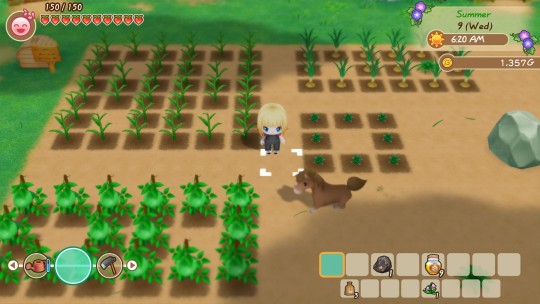
What did I think it was at first? I love a farming sim! Besides my previously stated love of Stardew Valley, one of my favorite GameCube games was Harvest Moon: A Wonderful Life. Tried to go back and replay it, but the neverending stomach growling really put a damper on my experience. Hopefully they remake that one someday!
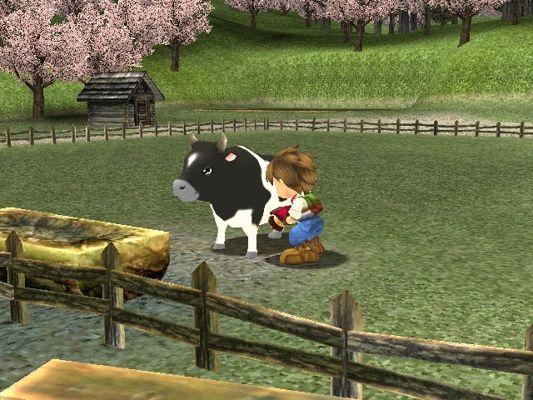
This game itself is a remake of Harvest Moon: Friends of Mineral Town. I haven’t played that game. I was a little confused when I saw this at first because I thought Story of Seasons was an entirely different franchise. I think “Story of Seasons” games are still made by the Harvest Moon team, and Harvest Moon games are something else entirely? I’m not sure.
How was the character creator? I was pleasantly surprised. You can choose from 2 masculine and 2 feminine avatars, and I think you can select your character’s gender independently of the avatar you chose? I think it would have been really cool to have a more androgynous avatar option, even if you still have to choose between he/him and she/her pronouns for text reasons. Also, you are no longer locked in to opposite-gender candidates for marriage - you can marry anyone! Love that and long overdue. There’s a difficulty selection process as well.
How was the game? At first, I felt a little meh about it. I don’t love the art direction (honestly, I think it looks really subpar for a game released in 2020) and the music is not great. Then I binged it for 6 hours in 2 days.
The standard chore routine gameplay is the heart of the game. If you’ve ever played a game in this genre, it will feel very familiar. There’s mining and foraging, though I felt like both weren’t very fleshed-out compared to other games I have played.
The characters in the town feel alive, and it was exciting to get to know them! I found myself motivated to talk to everyone and build relationships with them. I decided to romance best girl Popuri. She’s so cute!
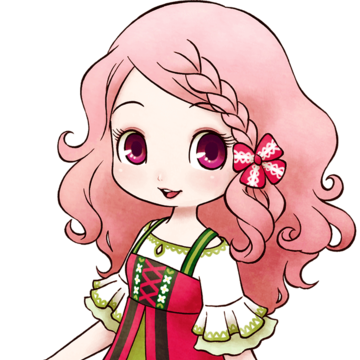
The cast is super huge, though, and it was tough to keep track of all the boys with brown hair and brooding faces.
What did I not love? Part of the fun in Stardew Valley is optimizing your farm so you can have your energy to do other things. For example, you spend a lot of energy watering your crops, so it’s advantageous to build sprinklers so you can do other things with that energy. Not so in this game - which got to be a little grindy.
I also thought the festival layout was odd. For the first few festivals, I was invited to participate even though there was no way I could have unlocked the gameplay feature required. That was a bit of a bummer, honestly.
At 6 hours and $34.99, was it really worth it? I think that if you played the original game, the nostalgia factor will make this a must-play! For me, though, it felt much less feature-rich than Stardew Valley and it got pretty grindy. I will definitely come back to it, though!
0 notes
Text
Best Games of 2020
2020 was a lot. It will be remembered for many things far above and beyond video games. COVID-19 shut the world down in a way never seen in my lifetime. It changed day to day life for many of us, and cost many of us loved ones. It was also the year when the ugly parts of our capitalist society were shown in broad daylight. It feels like 2001 again in that our lives will be divided into pre-2020 and post-2020.
For me personally, I was able to keep my job and work from home, and no one close to us died to the pandemic. We stayed home as much as possible, wore masks, wiped down groceries, and did our best to control what we could. It can be hard to talk about stuff like video games and sports with the usual sort of fervor when the world feels like it’s falling apart around us. It feels like playing the violin aboard the Titanic. But self-care is especially important in times like these, and it’s healthy and necessary to close Twitter, or for-the-love-of-god fucking Facebook and get a breather sometimes. Finding a balance where I could stay informed without completely submerging myself in misery wasn’t always easy.
And so. 2020 was a pretty good year for games, though it must be noted that there is a cost to that escapism - the industry is rife with stories of abuse, burnout, and coverups from companies such as Ubisoft and CD Projekt Red, Naughty Dog, and many others. That can add an additional layer of exhaustion to what is supposed to be a relaxing escape. So I can understand the people who say they don’t want to hear about abuse in industry, they just want the games. But also, fuck those people. “I don’t care if you suffer to entertain me, I just don’t want to hear about it.” Fuck the whole entire way off.
But I digress. Like most years, I played a lot of games. I played a lot of coop beat-em-ups with my kids this year. Minecraft Dungeons and Streets of Rage 4 didn’t make the list, but I spent hours playing them with my middle child. And it wasn’t a 2020 release, but I had a blast playing River City Girls with firstborn. It was a good year for fans of tactics games with stuff like Gears Tactics, Troubleshooter, Wintermoor Tactics Club, and Fae Tactics. 2020 also saw new console releases, though the launch lineups were especially thin.
Gaming-wise, 2020 was the year of Xbox Game Pass for me. I spent most of this console generation (justifiably) dogging Xbox for their lack of platform exclusives, but I decided to pursue an Xbox Series X before a Playstation 5. Game Pass is the main reason for this. The “Netflix for games” thing has finally become a reality, and Sony just doesn’t have an answer for the bonkers value of Game Pass. We head into the new console generation with Microsoft leaning heavily on Game Pass subs, Sony still banking on a few console exclusives, and Nintendo, uh, doing their own thing over there. What a fascinating time for the industry.
Honorable Mention
It’s an honor just to be nominated.
Monster Sanctuary

If you start with Pokemon, strip away the anime, and mix in a healthy dose of metroidvania, you have Monster Sanctuary. This means there are monsters to collect, level, and evolve, and lots of combat revolving around elemental strengths and weaknesses. And I am here for that shit. A game like this lives and dies by its combat, and it’s very satisfying here. The game has plenty of choices about which skills to focus on for each monster, which gear to equip, and which monsters to keep in your active roster.
That said, between a couple of nasty difficulty spikes and some super-frustrating puzzle rooms, I was close to walking away from the game on multiple occasions. It’s a testament to the game’s quality that I kept coming back to it.
Animal Crossing

Animal Crossing on the Gamecube is one of my favorite games ever. Each game in the series since the first has felt like a small incremental change from the original. I played Wild World on the DS quite a bit, City Folk a bit less, and A New Leaf not at all. I was thinking that maybe enough time has passed that I could get wrapped up in New Horizons, but I fell off it after a month or two.
I’m wondering what I would want from a new Animal Crossing game, and the answer is nothing. How much can you change the game and still have it be Animal Crossing? I don’t think the game is bad by any means. My whole family shared an island community for a couple of months. It’s impossible for a new game in the series make me feel the way that first game did.
The most memorable part of New Horizons is the museum. The museum is huge and absolutely lovely, with fish, bugs, fossils, and art each having their own wing. There were a few nights where the tranquility of the museum made for a nice end of the day.
Tell Me Why
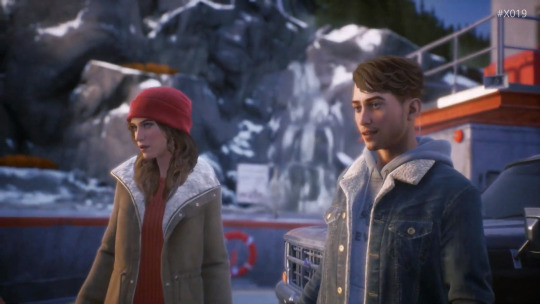
My wife, firstborn, and myself have made a nice routine of playing through “choices matter” games together (starting last year with Detroit Become Human and following up with Life is Strange 2). Tell Me Why is the latest one one of these we tackled as a group. These game have created some memorable moments for us; who could forget their child yelling for them to “shoot the hooker”? (thank you, Detroit Become Human).
Tell Me Why was on my radar because it’s One of These, but also because it features a transgender protagonist. As a parent of a trans child, I was both excited at the prospect of this and also worried that it is such an easy thing to fumble. I’m pleased to report that DONTNOD handled the writing of the trans person very well without being hamfisted, preachy, or tryhardy with it. The character of Tyler is a believable trans man, and the topic is spoken of matter-of-factly without placing special focus on it; being trans is a part of Tyler’s story, but it’s not the entirety of his identity.
Less impressive to me was the story itself - especially the way it wrapped up its main conflict. The game trades in the idea of memory being imperfect, which is fascinating in and of itself, but I did not like it as a game mechanism. How did this REALLY happen? One character remembers it one way, and the other remembers it differently. Choosing between them felt cheap and hollow to me; I want you to tell me what happened, don’t ask me to choose. Still, I enjoyed my time with the game, and it feels like a step forward in mainstream storytelling for LGBTQA characters.
Ghost of Tsushima
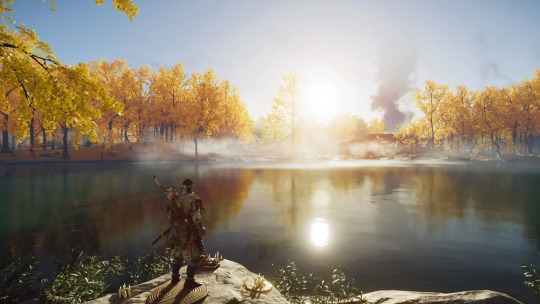
Ghost of Tsushima is flat out gorgeous. Practically every area and every moment in the game is begging to screenshotted to the point where it can sometimes pull me out of the game world a little bit. That’s not necessarily a complaint because, as I said, the game is freaking beautiful. But every part of the world looking like a painting makes it feel more like it takes place in a fantasy world and less like a game from feudal Japan.
I also had some ludonarrative dissonance going on with the game; you play as Jin, one of the few surviving samurai in his homeland which has been invaded by the Mongols. His uncle is being held prisoner, and combatting the occupying force would be impossible without using dishonorable techniques like hiding, attacking from a distance, and ambushing from the shadows. I, however, have no qualms and savored every opportunity to catch my foes unaware. So Jin voices his doubts, then goes into a camp and proceeds to cut his enemies down from shadows as I cackle with glee.
Ghost of Tsushima also combines dark souls-esque* combat with Ubisoft-style open world gameplay where you’re hunting down icons on a map. That kind of open world game is hard for me top stick with, especially after I spent ~30 hours with Assassin’s Creed Origins early in the year. All of makes it sound like I’m pretty down on Ghost of Tsushima, which I’m not. I’m hoping I’ll come back to it at some point when I have more of an appetite for One of These.
Crown Trick
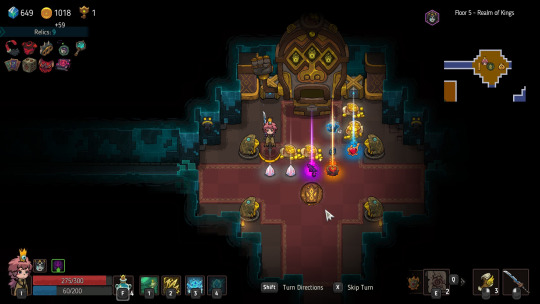
My Dungeons of Dredmor hole has not been properly filled in a long time. Chcocobo’s Mystery Dungeon is the closest I think. These games are what I think of as roguelikes, though the progression between runs makes them roguelites. *tips fedora*
Crown Trick is a turn-based dungeon crawler where the map is a grid, and each time you act, the enemies act. Add to this clockwork puzzle gameplay a good variety of weapons, relics, and events and you’ve got a lot of replayability. It doesn’t have Dredmor’s ridiculous combination of skill classes, but it does have a neat Mega Man-esque system where you defeat minibosses and add their skill set to your build.
Top 10
10. Star Renegades
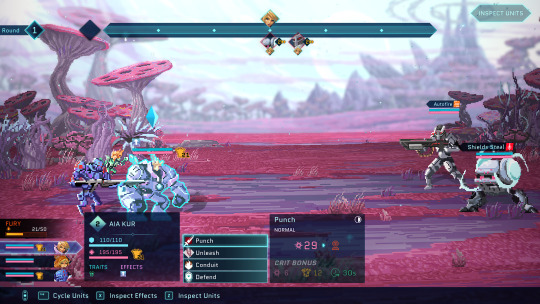
Star Renegades was not on my radar at all until I heard Austin Walker talk about the game on Waypoint Radio. Two things gave me pause:
- It’s a sci-fi-ass game. It’s a setting I don’t care for. Star destroyers and aliens and galactic battlecruisers aren’t my jam.
- Austin Walker’s enthusiasm is infectious. I’ve tried games after hearing him gush over them and those games haven’t worked for me.** That’s not an indictment, he and I just have different tastes.
Star Renegades ticks a few important boxes for me: it has a lot of characters to unlock, it’s highly customizable, and the combat is turn-based with a twist. Every action, whether friend or foe, appears on a timeline. Some attacks will push their target’s action back on the timeline, so there’s a puzzle element to the combat that keeps it feeling fresh. You can choose the makeup of your party on each run, which helped give the game a buttload of replay value.
It’s not flawless by any means. The writing tries a little too hard to be cheeky and ends up feeling tryhardy and a little flat. A decent run in the game would often take 2-3 hours, which makes it feel deflating when it ends in failure - which it frequently did. The sections of the game where you move between zones on an overhead map feels needlessly clunky, and sometimes I ended up with movement points I couldn’t spend because of how the game handles that system.
I enjoyed Star Renegades a lot, but my time with it was weird. The game has unlockable characters, so unlocking them all was my first priority. The game’s runs are pretty long, I was playing sub-optimally trying to unlock things, and the game is more difficult than I’d expected. It took me a long time to complete the unlocks, then I had a hard time actually finishing a run successfully. Eventually I was ready to be done with it and turned the difficulty down to easy**** just to finally get a W. Still, the positives far outweigh the negative here, and Star Renegades is one of my favorite games of 2020.
9. Immortals Fenyx Rising
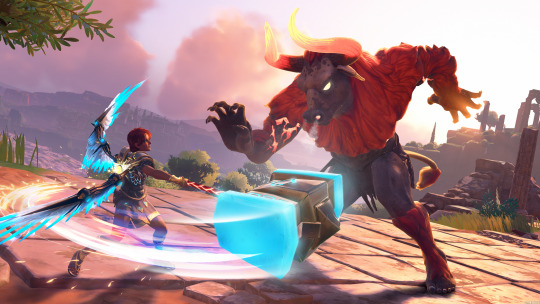
Man, something happened to me this December. I’m currently finding myself playing a lot of Forza Horizon 4, Destiny 2, and Immortals Fenyx Rising. None of these is My Kind of Game. Immortals is probably the least surprising of these, because it at least has swords and bows and stuff.
Still, I dismissed and mocked Immortals Fenyx Rising when it was first shown. It was called Gods & Monsters back then, and the idea of Ubisoft making yet another open world game, this time aping Breath of Wild was not appealing at all. I only ended up with the game after trading in Cyberpunk 2077 for Xbox credit and looking into Immortals because I was very surprised to see it on Game Informer’s game of the year list.
To get a few things out of the way, it absolutely recycles a lot from Breath of the Wild: you’ll be hang gliding, scaling walls as a stamina meter drains, finding shrines that contain puzzles and combat and climbing towers to get a vantage point and find points of interest on the map. The latter feels the most fumbled in this game - you can zoom in and survey the landscape, and your controller vibrates when you are looking near a point of interest. Move the cursor over it and press a button to reveal it on the map. They split the difference between Assassin’s Creed’s “all the icons pop in automatically” and Zelda’s wonderful “manually mark places that look interesting to you on your map” system and ended up with something neither functional nor interesting.
That’s where my complaints end though. The game’s art style is similar at a glance, but it’s vibrant and gorgeous, and never feels like Breath of the Wild. The combat is snappy, responsive, and challenging. The puzzle design is often creative, clever, and rarely frustrating; most of my frustration has come from my overthinking the puzzle solutions. There is plenty of gear to find, and the game’s cosmetic options are intuitive and welcome. The game’s narrative is better than I expected; it feels like a B-tier Disney movie. The writing has made me smile a few times, and made me roll my eyes a few times. Zeus as comic relief is a pretty major miss, but it’s fine apart from that. It helps that I’m already familiar with Greek mythology.
It’s a huge, beautiful world where traversal and combat feel great. It’s sometimes hard to get anything done because I am constantly distracted by tracking down an icon on the map, or just exploring because I saw something cool or strange. Not all of the puzzles and challenges work, but that’s okay because I can move onto something else. Immortals Fenyx Rising is this year’s Dragon Quest Builders 2: gaming comfort food where it feels good to sit back and check things off a list at the end of a long day. Still don’t like the name though. And fuck Ubisoft.
8. Atomicrops
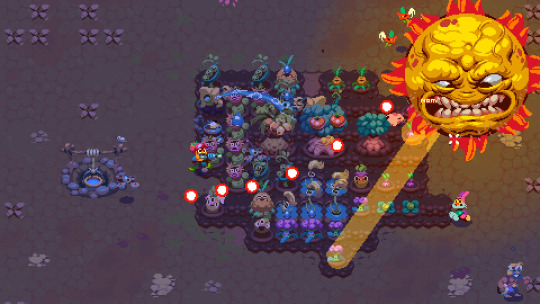
The first mention of Atomicrops I remember was “What if Stardew Valley was a twin stick shooter?” which is bullshit, because the games bear no resemblance beyond “there’s farming”. Beyond that first blurb, what appealed to me is the idea that the game’s days take place in 2 phases: during the daytime, you go out and fight baddies to gather seeds, and at night the baddies invade your farm and you fight them off while planting and watering crops.
It’s also a run-based roguelike, and I am 1 of 26 remaining people who is still psyched to play those. Give me a challenge, mix up the details, let me upgrade stuff between sessions, and turn me loose. The game has a good variety of weapons and the challenge is satisfying and rarely feels unfair (apart from the bullet hell problem of too much stuff on the screen at times). I don’t love the art style, but the music sure makes up for it.
7. Wintermoor Tactics Club

A game needs more than charm to be memorable and enjoyable. Charm can go a long way though, and Wintermoor Tactics club has it in spades. It takes place at a small college, and you play as a girl named Alicia. She and her friends are members of the school’s tactics club, and much of the game takes place around a table littered with graph paper, rulebooks, and snacks. As someone who loved tabletop RPG’s in simpler times, and never had the traditional college experience, a prettied-up version of that appeals to me in a huge way. It’s not wholly idyllic though, and it touches on issues of discrimination and what it’s like to be an outcast.
The gameplay itself is pretty straightforward tactics stuff and it works fine but isn’t really the draw here. I was propelled through the game largely by a desire to meet the next character, get the next story bit, and keep basking in the game’s wonderful aesthetic and smart writing. There’s something lovely about sitting around the table and playing a game with friends, and this game really captures that.
6. Ratropolis
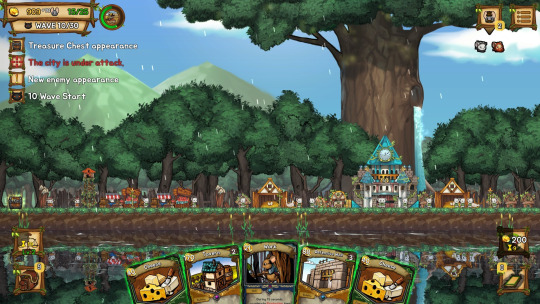
Ratrpolis is “A fusion of roguelite, tower defense, city-building, and deck-building!” which sounds like a hodgepodge of nonsense. And it kind of is. It’s a city building game where you are periodically being invaded from either the left or right side of the screen (or both). You choose from 6 leaders, each with their own pool of cards and play style, start with a basic deck of cards and slowly evolve it. The cards consist of buildings, military units, and various economic and military buffs. The major things that set this apart from favorites like Slay the Spire are that it happens in real time, and there is an economic aspect to manage. Tax money comes in every few seconds, and it’s possible to make poor decisions early on and not understand why you feel hamstrung later.
I spent a lot of games like that, not really understanding why I’d be doing okay and then get overwhelmed. I had a few rage quits early on, but I could tell that there was something there. I started approaching it with the mindset of building an economic engine in the early game, and I started having a lot more fun and success. Each of the 6 leaders feels distinct, and figuring them each out has been a lot of fun. Runs are usually no more than about 30 minutes, which feels about right.
5. Final Fantasy VII Remake

Despite identifying as a big JRPG fan, I’ve never enjoyed a mainline Final Fantasy game enough to finish it. This year I finished 2 of them: Final Fantasy XV and the Final Fantasy VII Remake.*** I played the original Playstation Final Fantasy VII release, I think I got through disc 1 and a little ways into disc 2. It didn’t resonate with me, so I came to this year’s remake with no reverence for the game. When many of the original game’s fans got upset with how much the remake changed the script from the source material, I didn’t have a horse in that race.
The remake is gorgeous, the combat and upgrade systems are engaging, and the story is interesting enough to keep me wanting to see what’s next. The 1997 release of the game had some stuff that isn’t going to play the same in 2020 like the scene where Cloud is crossdressing, the game’s themes of environmental activism, and, uh, the entire Don Corneo storyline come to mind. But the game handled all of this pretty well. I’m glad to say that this is one of the best RPG’s I played this year, and I look forward to the next entry whenever the hell it comes along. Cloud is still an unlikable punk though.
4. Monster Train
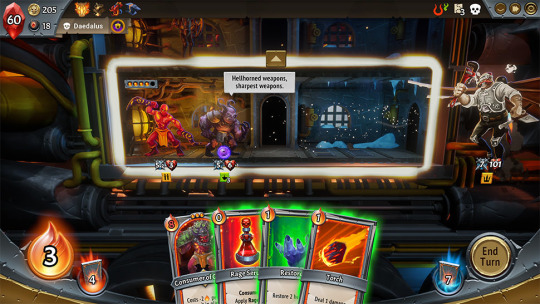
Slay the Spire was a surprise hit a couple of years ago, and inspired a lot of folks in the indie space to take a crack at the deckbuilding genre. Monster Train managed to to take inspirations from Slay the Spire but still feels like very much its own thing. Both games have you progressing through a series of encounters consisting of battles, shops, or small events trying to defeat the big bad at the end of a journey. You start with a deck of basic cards and upgrade them and add new cards along to way. You can’t really start a run planning on making a certain style of deck, you just choose from the cards available and watch the strategy form. The way this process tickles my brain makes these games endlessly replayable. The “one more run” is very strong here.
Monster Train differentiates itself in a couple of ways. First, where Slay the Spire was always just your one character battling one or more enemies, here you are summoning multiple creatures on the lower 3 levels of a 4-level train (I don’t know either). If the enemies reach the top floor of your train, they attack your core directly and eventually defeat you. This adds a strong spatial planning element - now you’re thinking about which combatants you want on each floor, and in what order.
The other notable difference between the games is that while Slay the Spire has four heroes, each with their own unique pool of cards, Monster Train has five factions. It’s one better. The first three factions feel pretty standard from a creativity point of view - red/green/blue are fire/nature/ice. The last two factions you unlock feel wholly unique though: there’s a faction that summons weak, cheap units and feeds on them for combat bonuses, and one that is made of candle beings who are powerful, but melt away. Okay, the real reason is that each time you play, you’re choosing a main faction (each has 2 champions to use from) and a secondary faction (you don’t get their champion, but you get access to their pool of cards). This makes each run feel unique and makes the game feel endlessly replayable. Even after unlocking all of the factions and their cards, and winning a run on the hardest challenge setting with each faction, I’m still playing Monster Train.
3. Spiritfarer

If Kentucky Route Zero is my “It’s Not You, It’s Me” game this year, Spiritfarer might be my “Love at First Sight” game of the year. The game’s striking visuals grabbed my attention immediately when I first saw the trailer at E3 2019, and it was billed as a game about saying goodbye. My only reservation was that it was coming from Thunder Lotus Games, whose previous titles (Jotun and Sundered) both fell flat for me.
Spiritfarer ended up being everything I was hoping for. You play as the newly-appointed ferryperson for the boat that transports souls from the land of the living to the land of the dead. Your ship acts as your base of operations, and you build living quarters, a kitchen, a forge, and lots of other facilities on it. The beings who join you on your ship are anthropomorphized animals, each with their own story. Your job is to help them be at peace, then send them to the next life once they’re ready.
In practical terms, you’re spending a lot of your time sailing from island to island to talk to people and find resources. There’s a plenty of crafting and time sinks in the game, and I appreciated the excuse to luxuriate in this game world. No game made me cry this year, but Spiritfarer (Alice’s story in particular) sure did try. It was the perfect respite for the nightmare that was 2020.
2. Yakuza: Like a Dragon

A lot of Yakuza fans were concerned over this game’s switch from the series’ usual brawling combat to turn-based RPG combat. I was not one of them. Everything about this game sounds like the sort of fan fiction someone like, well, like me would come up with on a late night drunken bender. “What if it was Yakuza, but like, JRPG battles? Why would that happen.....OH oh oh what if the main character was a big fan of DRAGON QUEST so he just, like, saw the world in those terms? You could have party members, and a Pokedex of all the weirdo scumbags you fight, and you could change jobs by going to a temp agency!”
All of that is in Yakuza: Like a Dragon. And I love it. The series’ producer says they decided to pivot to a turn-based combat system after positive reaction to an April Fools Day Yakuza RPG joke they put online. And there are some rough spots. Your party members get caught on the world’s geometry sometimes, and combatants are constantly milling around so AOE abilities feel like a crap shoot. The Yakuza series has always had about 30% too much combat, so translating it into a genre known for grindy gameplay feels like a perfect storm of sorts. Thankfully, I’m a fan of grindy RPG’s so all of this is directly in my wheelhouse.
This eighth game in the Yakuza series is the first with a new protagonist - goodbye Kiryu Kazuma, hello Ichiban Kasuga. Where Kiryu was very stoic, Ichiban is a hothead with the perfect mix of kindness, earnestness, and stupidity for a JRPG hero. He is an incredibly likeable and charismatic character, and I hope Ryu Go Gotoku Studio tightens up the battle system and keeps this iteration of the series running.
1. Hades

Hades seemed like a slam dunk. My favorite studio was making an action RPG based on Greek mythology. The announcement was the best possible version of “AND you can play it right now!” I bought it (in early access) immediately and played it a bit, but I didn’t want to burn out on it so I only briefly checked in on it every few months. As a result, my hype was pretty low when the game reached its 1.0 release.
Once I decided to fully engage with the game though, I was unable to put it down. SuperGiant’s games have the best writing, music, and voice acting in the business. That’s a pretty high bar to aim for, and they hit it once again with Hades. Both of their post-Bastion games (Transistor and Pyre) are games that I have to recommend with an asterisk though; the gameplay parts of each game is an acquired taste and will put some folks off.
Hades, however, I can give a full throated recommendation for. The gameplay is tight and the combat feels good. There’s a lot of variety in the weapons, so you can either find one that fits your style and stick with it, or do what I did and change it up every run. They also managed to achieve something incredible - they largely took the sting out of losing in a run-based game. There are things to unlock between runs as you’d expect from a roguelite. I found myself enjoying chatting with the denizens of hell as much as the moment to moment action gameplay. I’d respawn back home and make my rounds, taking to people and spending my cash. I had a route I’d travel each time, and that route ended with Skelly in the weapons room. Oh, the gauntlets grant a bonus if I use them this time....the door to start a new run is just right over there....okay I can do one more run tonight.
That personality and dialogue is sprinkled throughout the runs themselves too, in the form of the various Greek gods you talk to and get boons from. The variety in weapons and boons give the game tremendous replayability and give the game a deckbuilding feel. Every character in the game is incredibly well developed and well-acted. Zagreus is a likeable and relatable protagonist. He wants to get away from his disapproving father and find his estranged mother, and he and his father can’t see eye to eye.
The story and gameplay in Hades do equal lifting, the game is an incredibly complete package. The game also provided a couple of the most memorable moments of the year. Hades might just be SuperGiant’s best game. It’s certainly their most complete game.
*It’s very much on the lighter side of this gameplay style, akin to 2019′s Star Wars: Jedi Fallen Order. Plus there are difficulty settings, which I appreciate.
**Invisible Inc, Dragon’s Dogma, and The Outer Wilds come to mind.
***Final Fantasy VII Remake is only the first installment in a series
****Cloaked in shame and failure.
0 notes